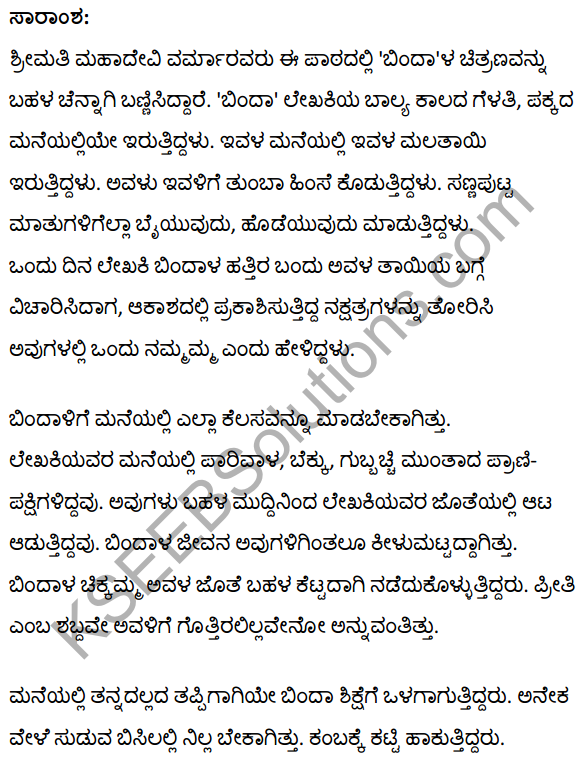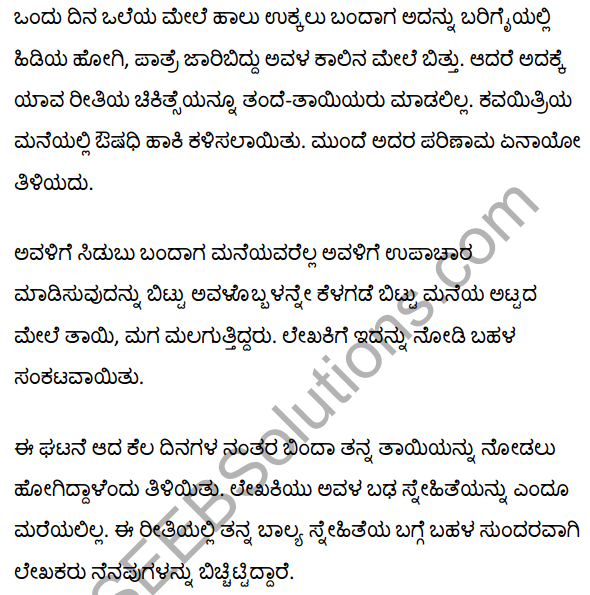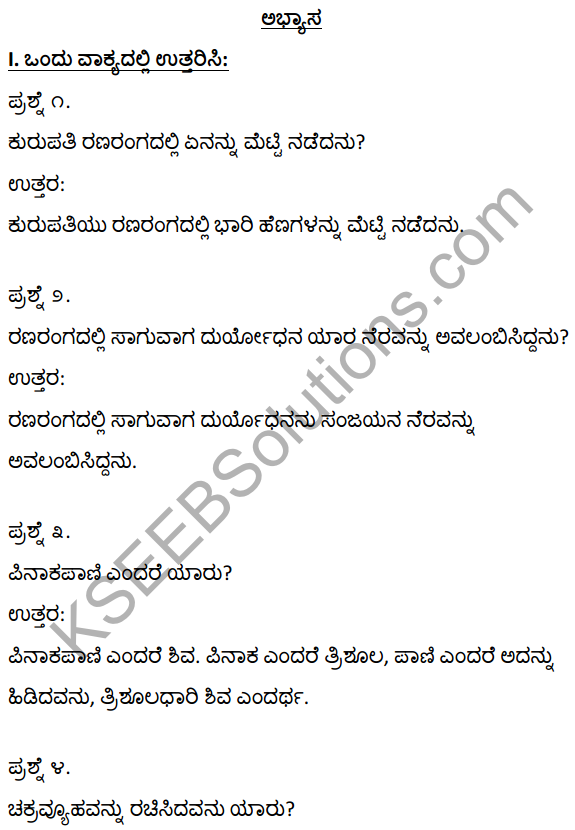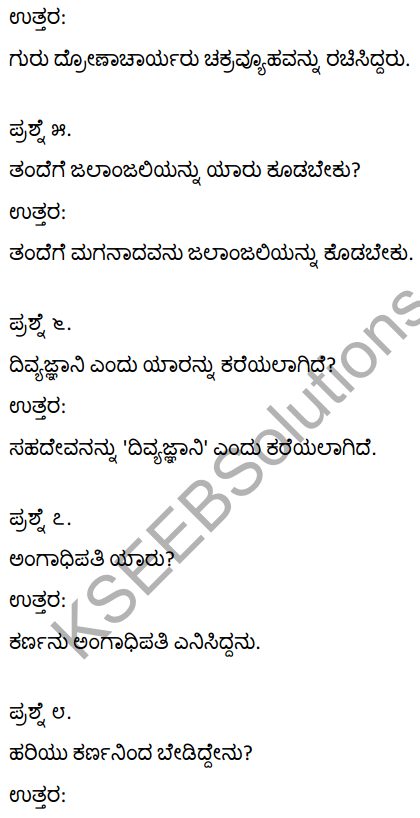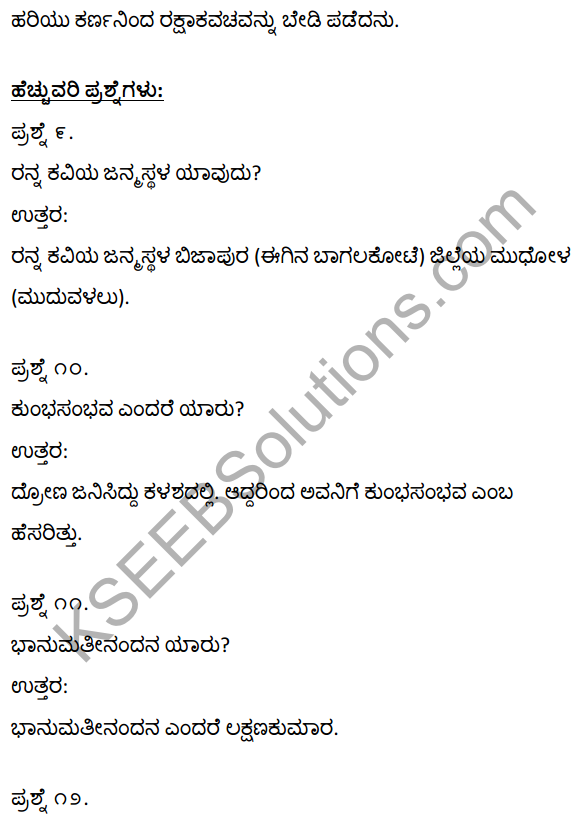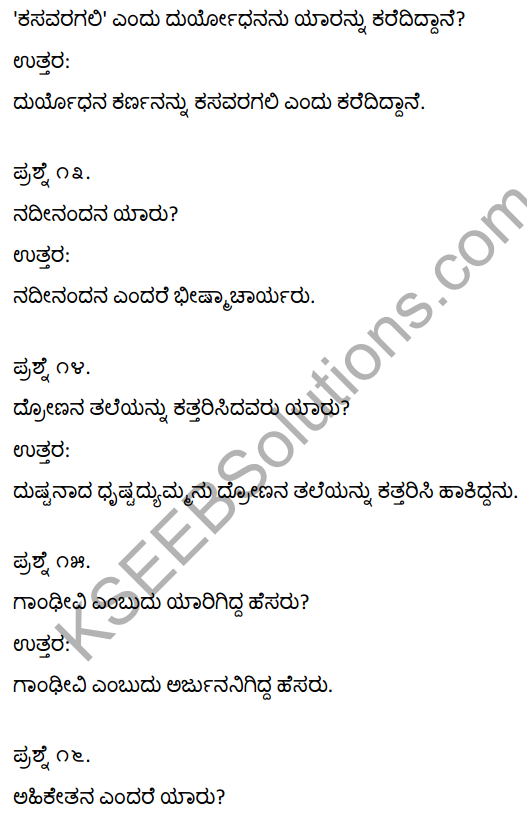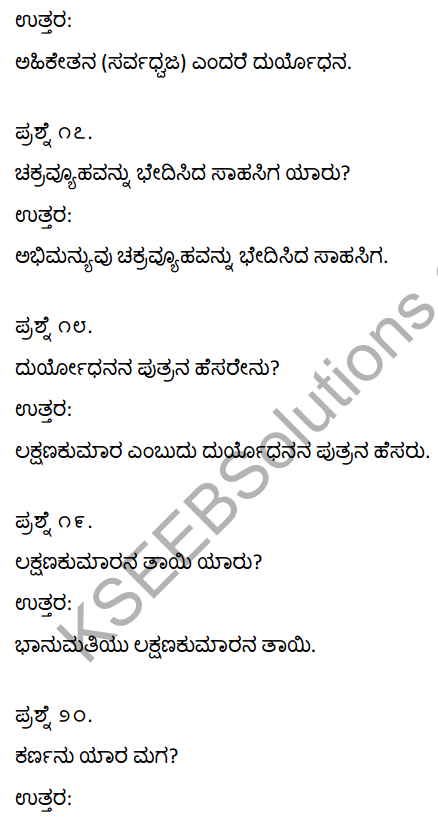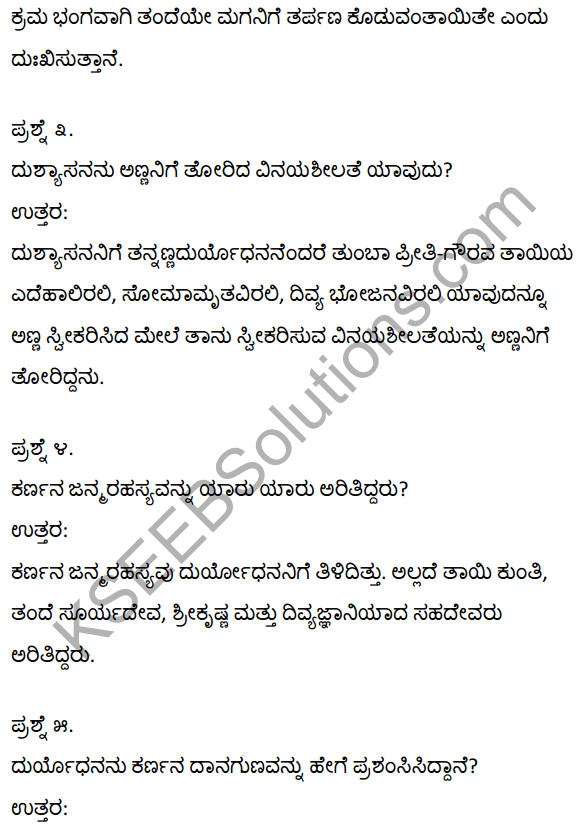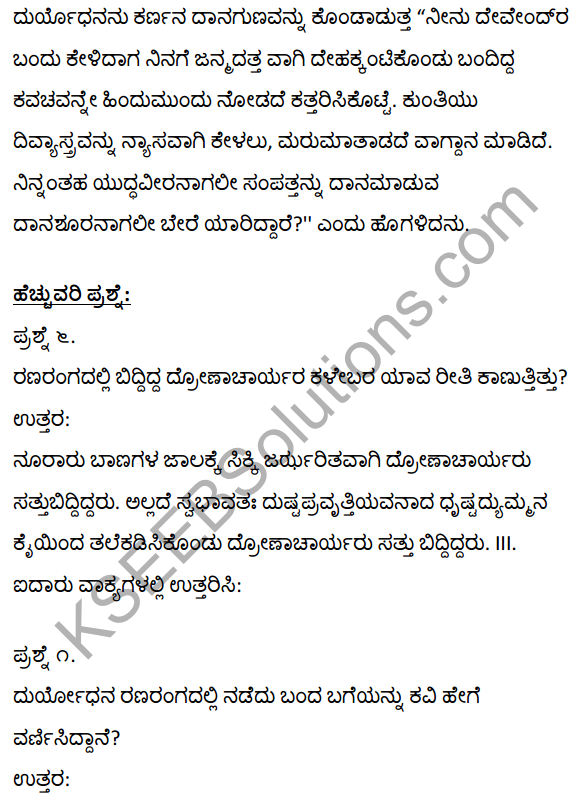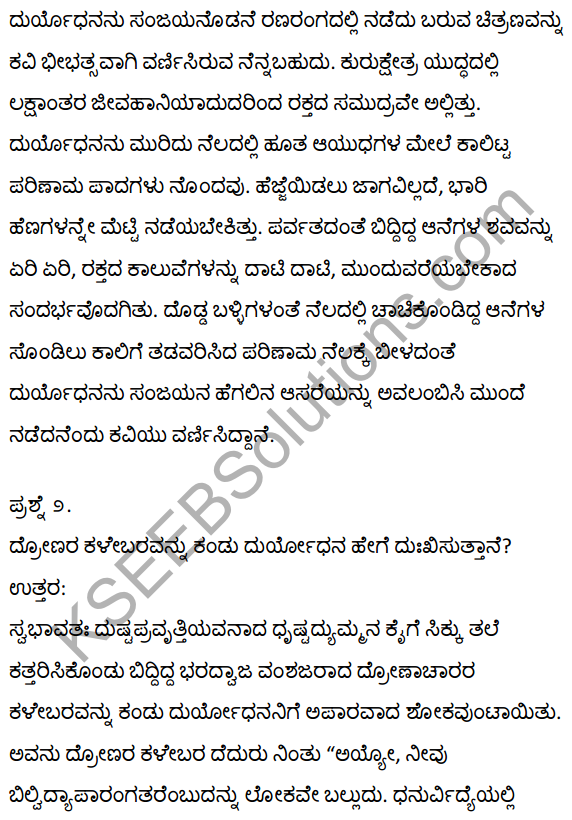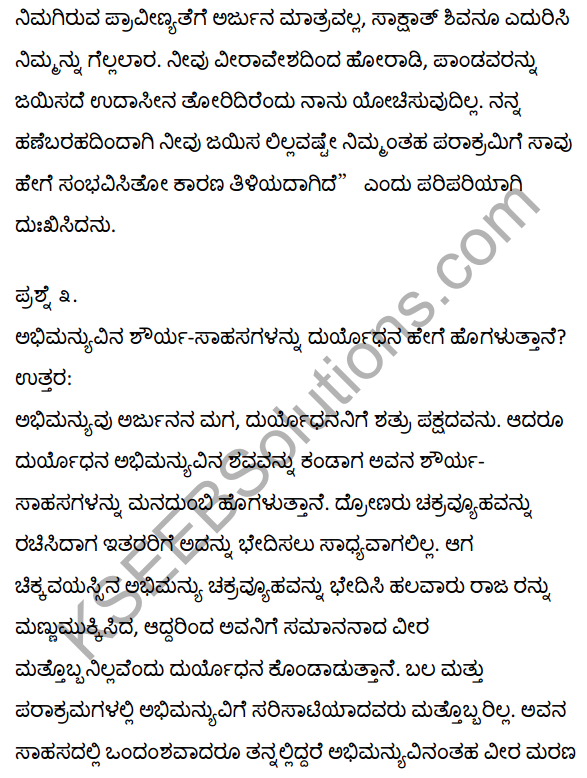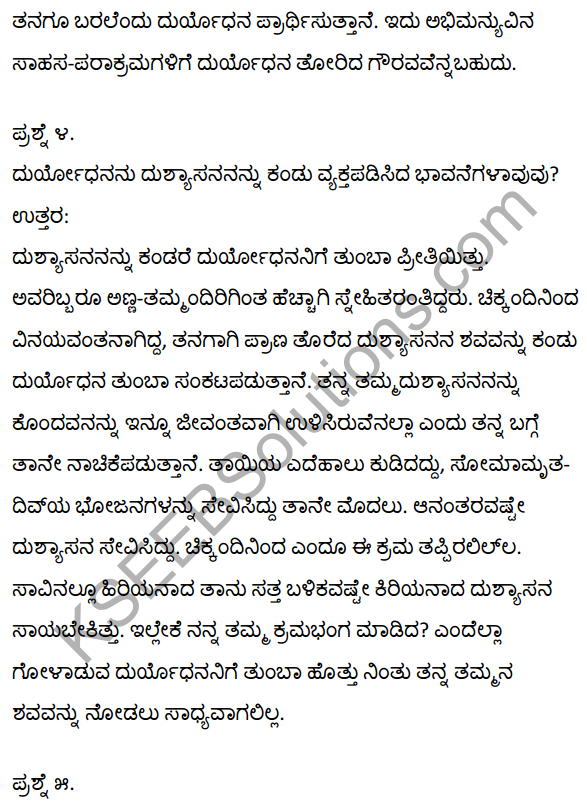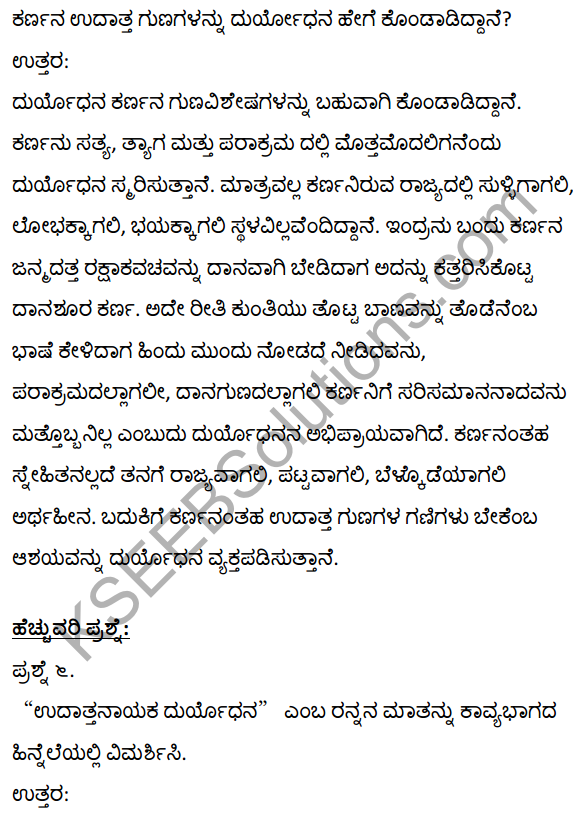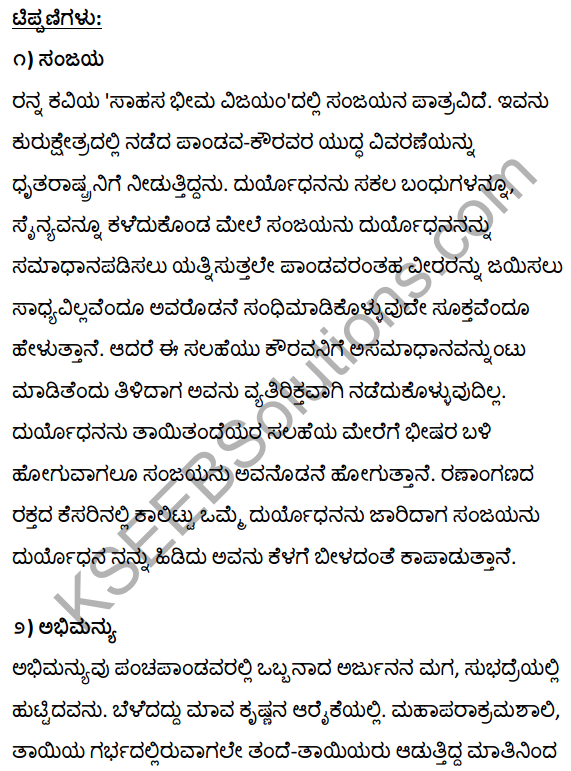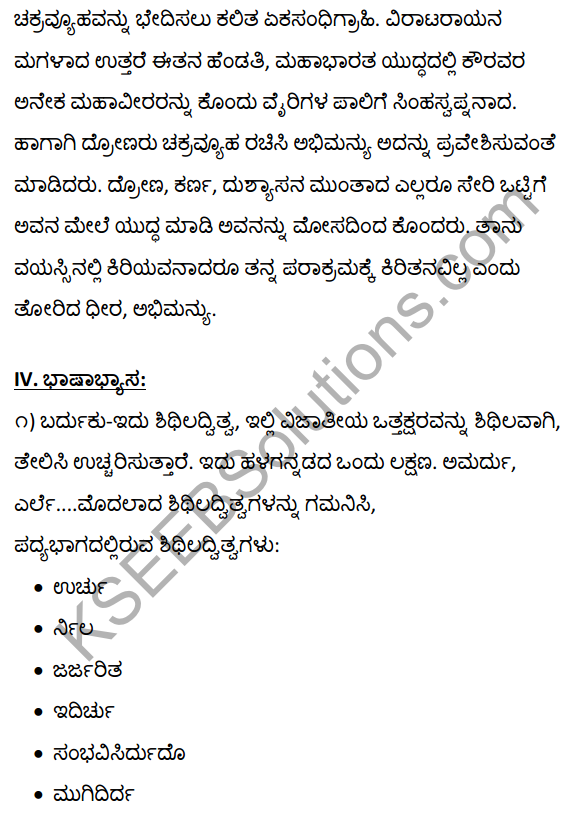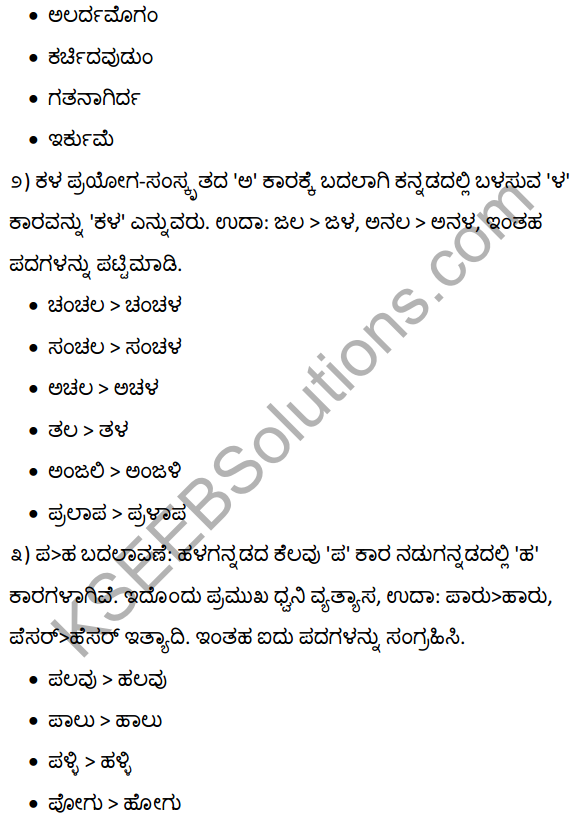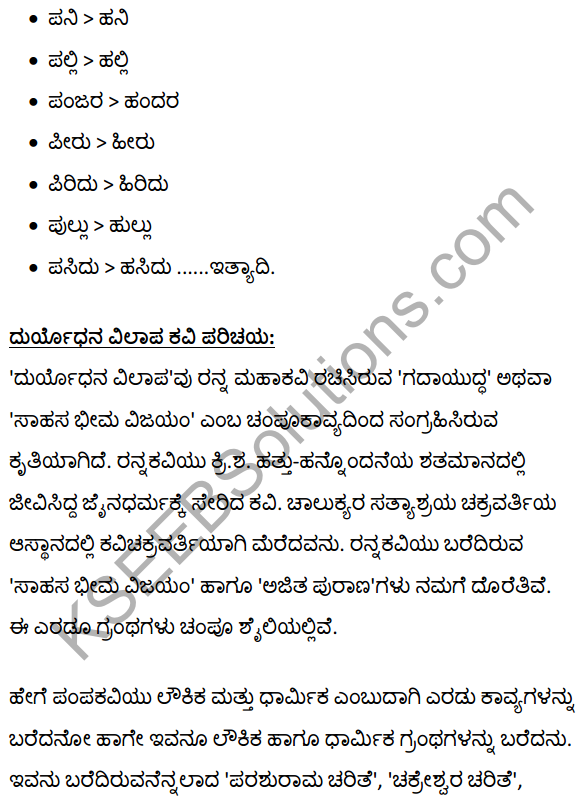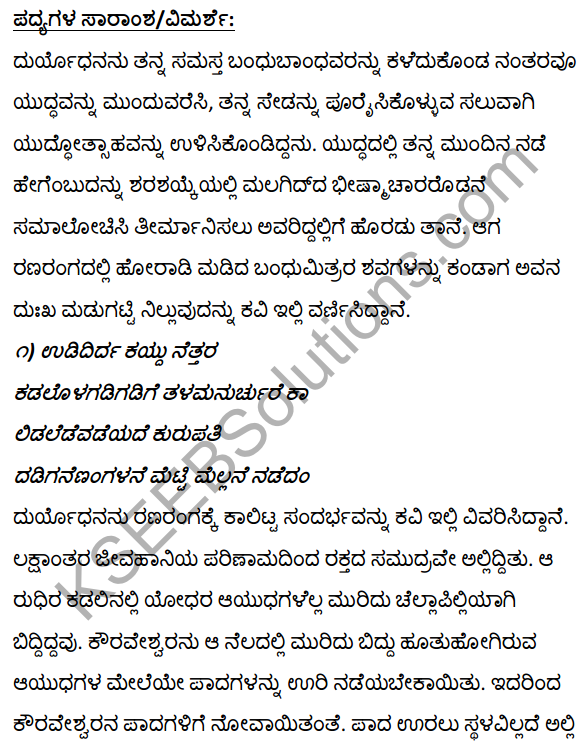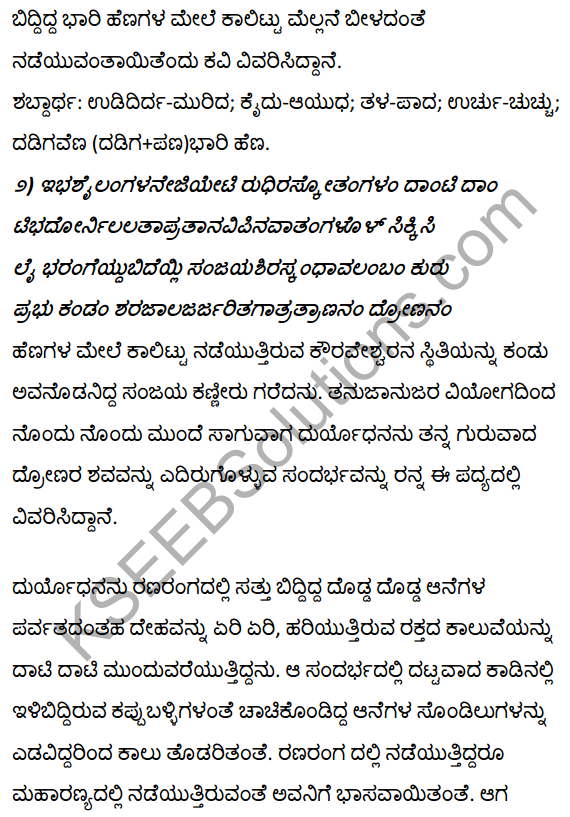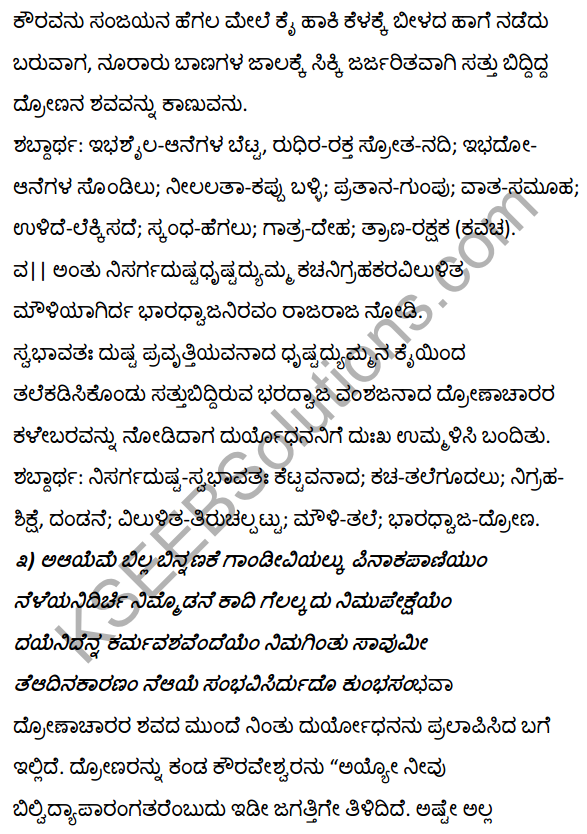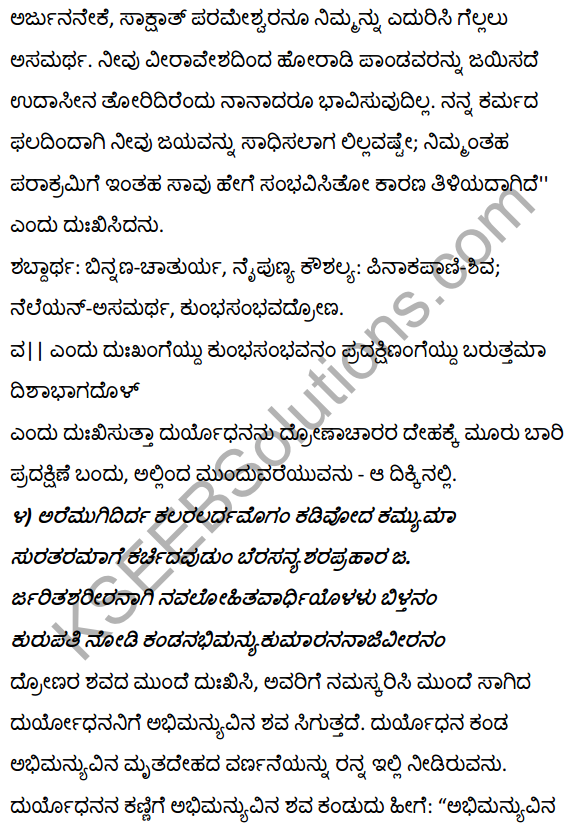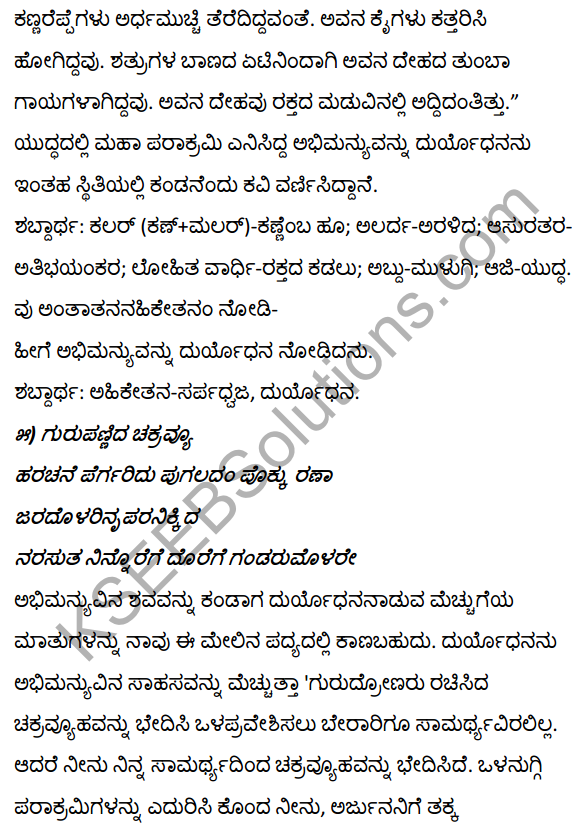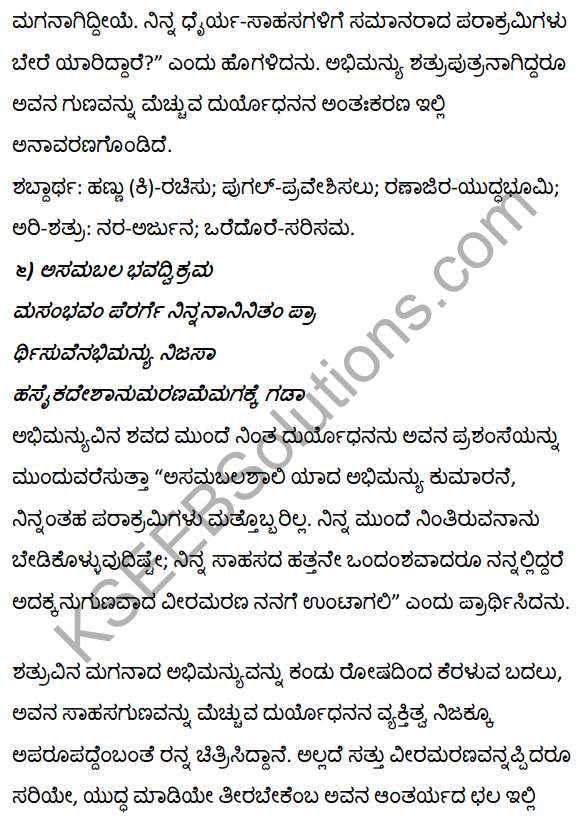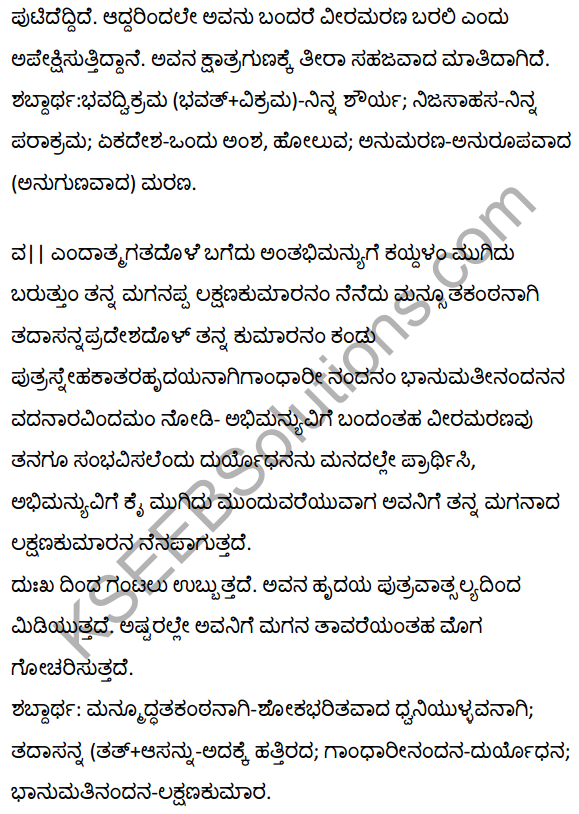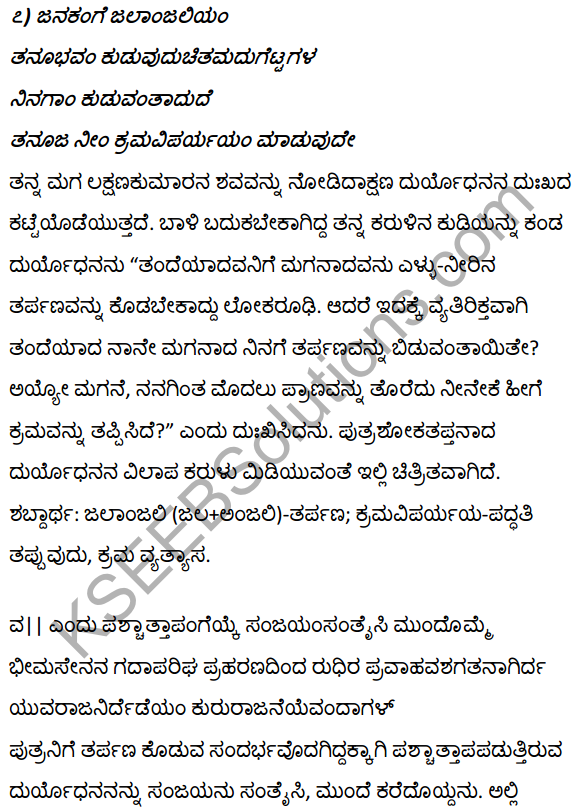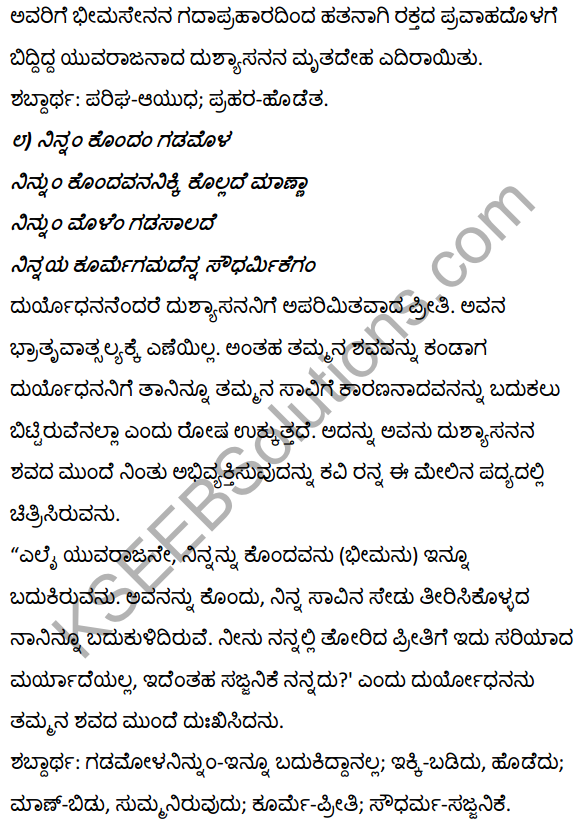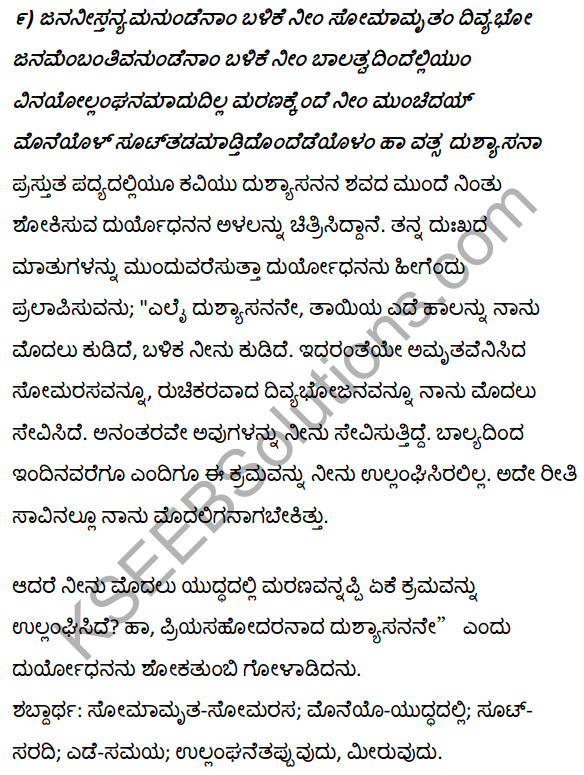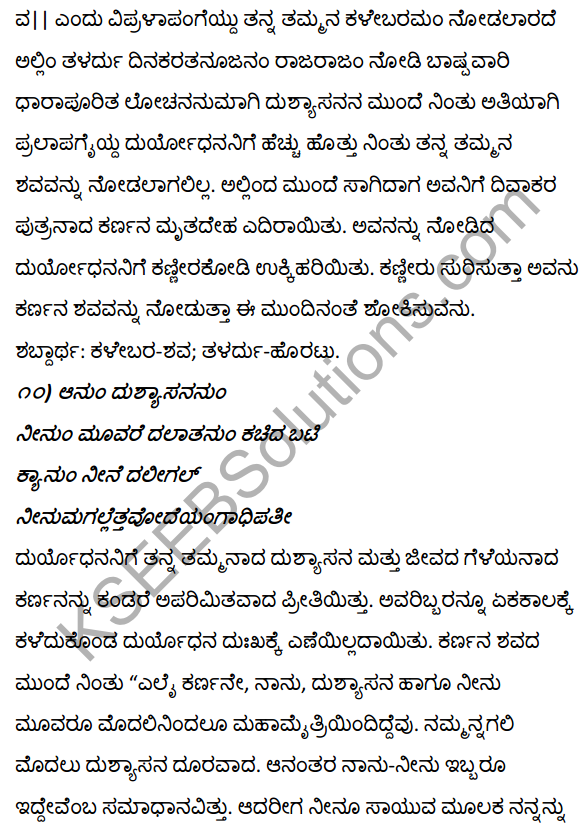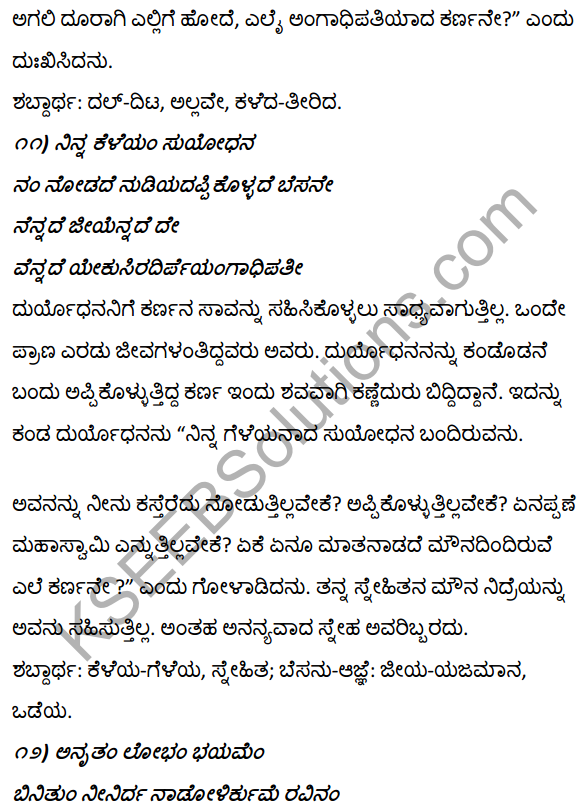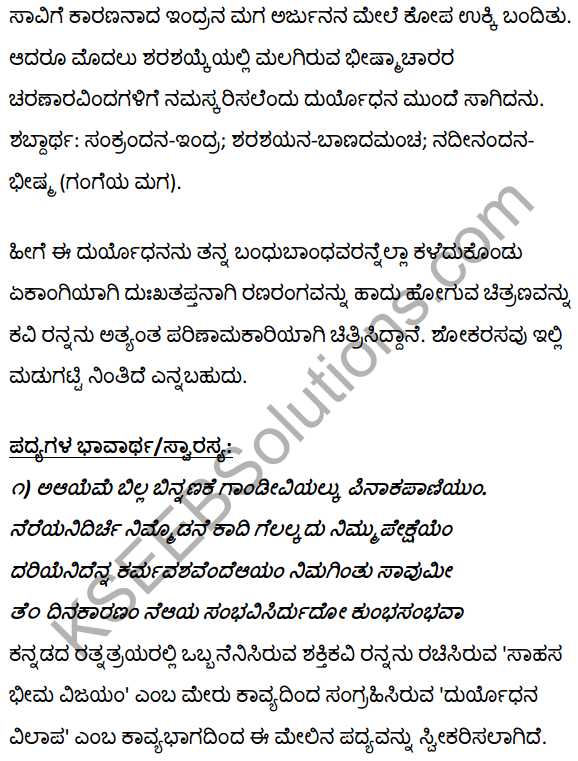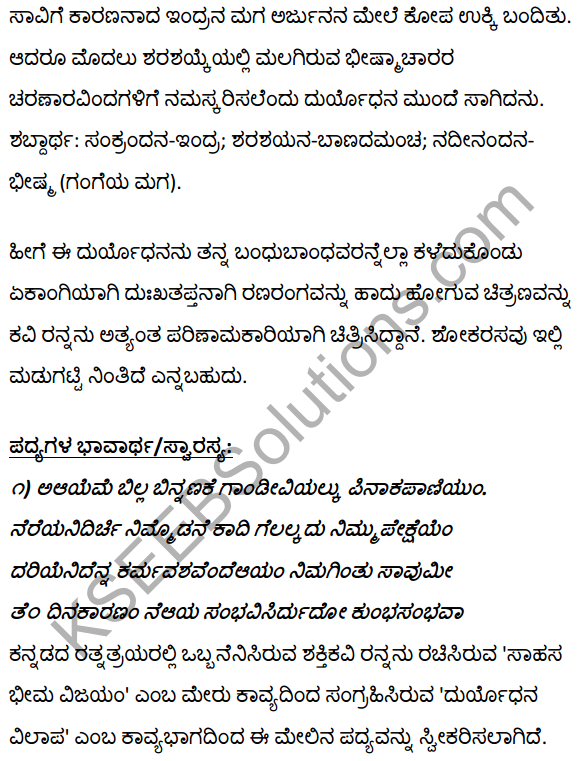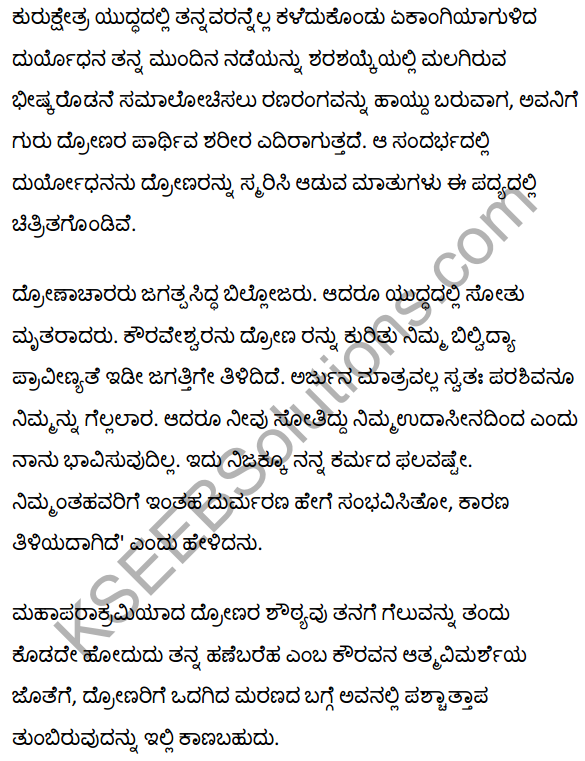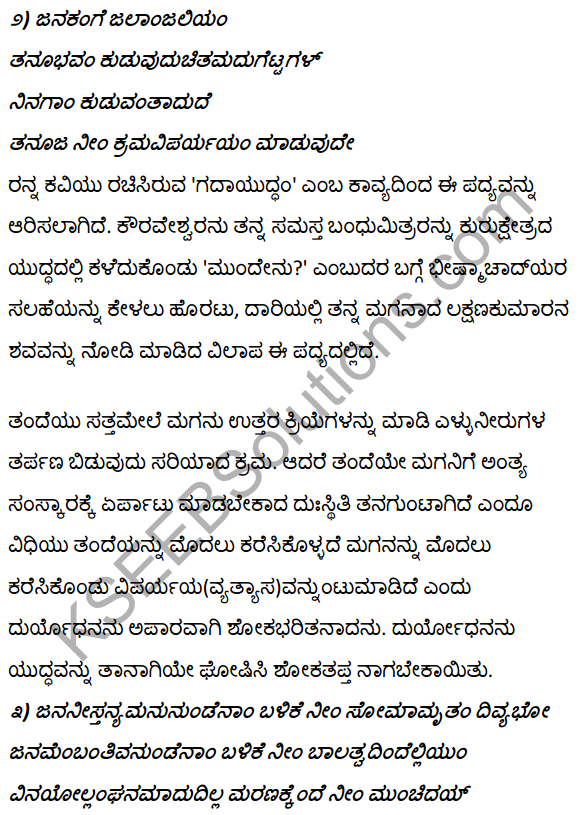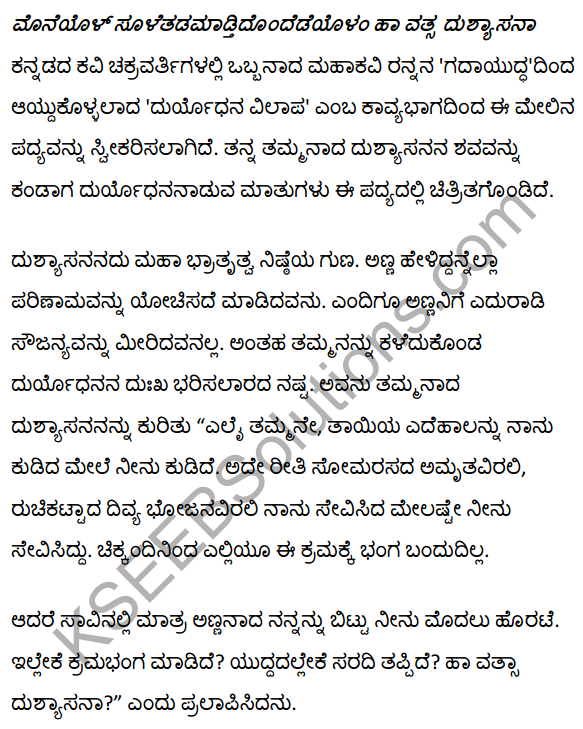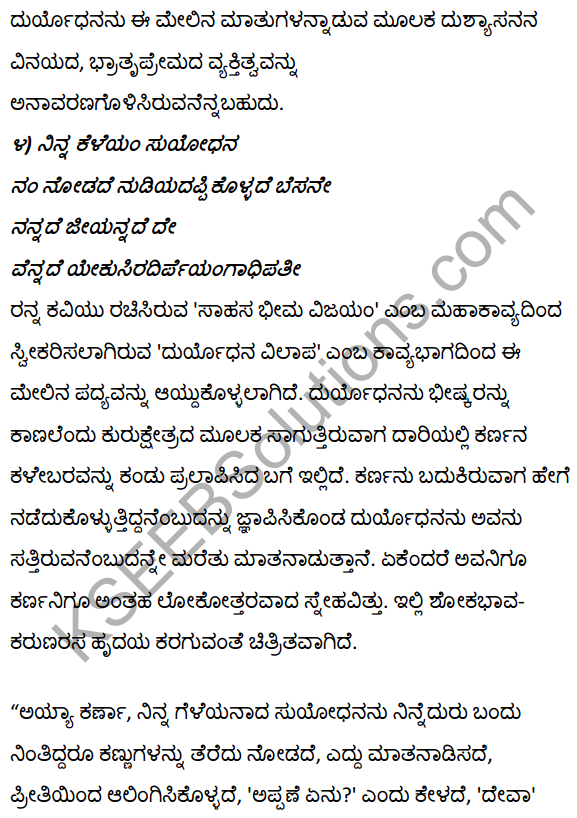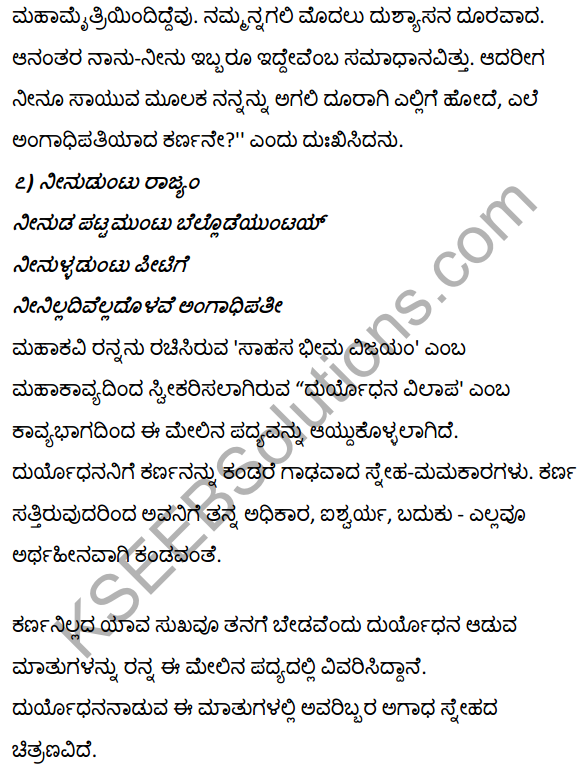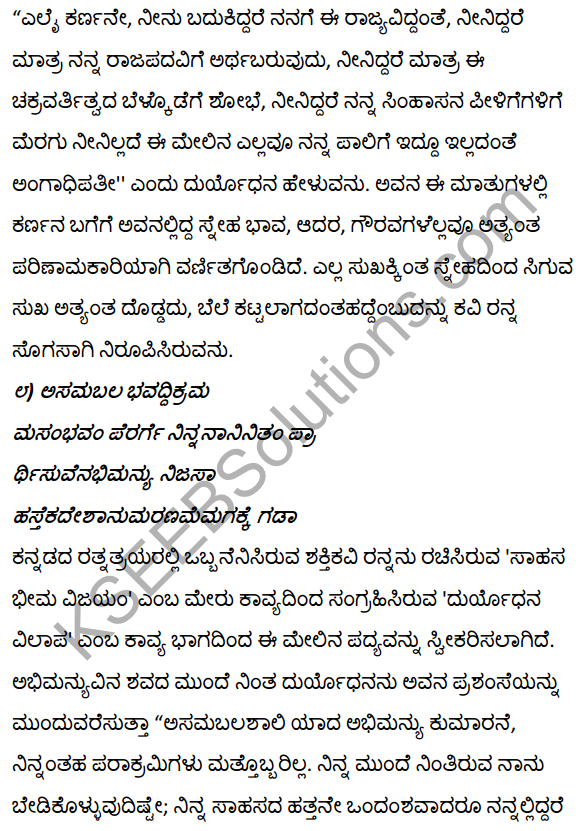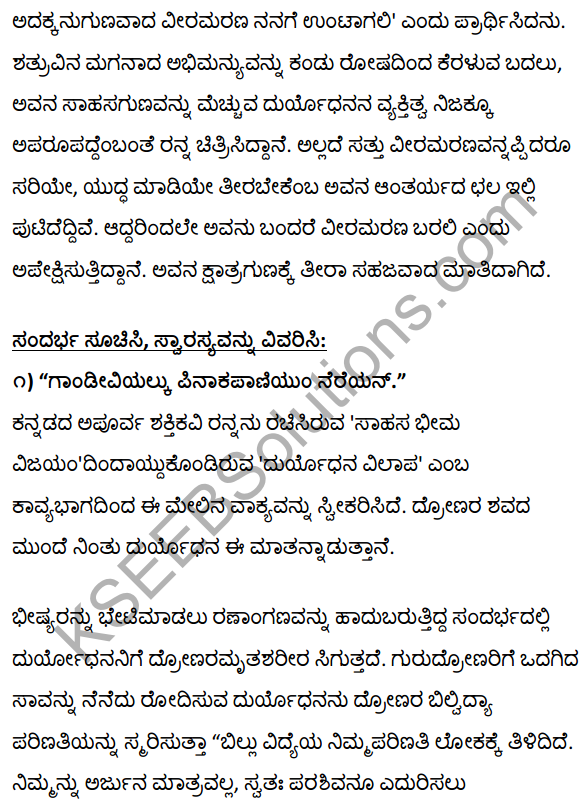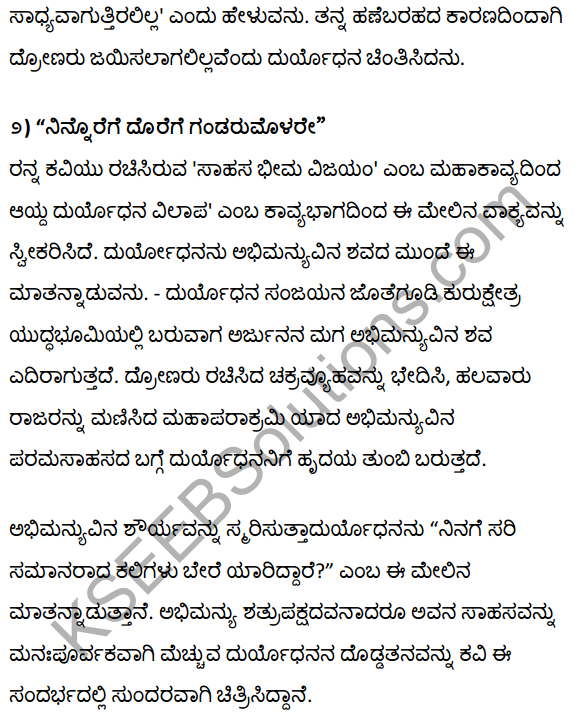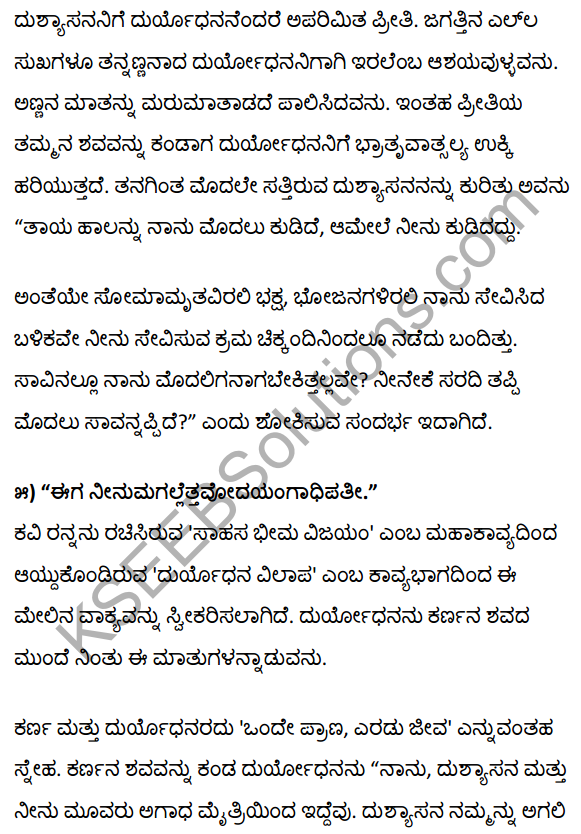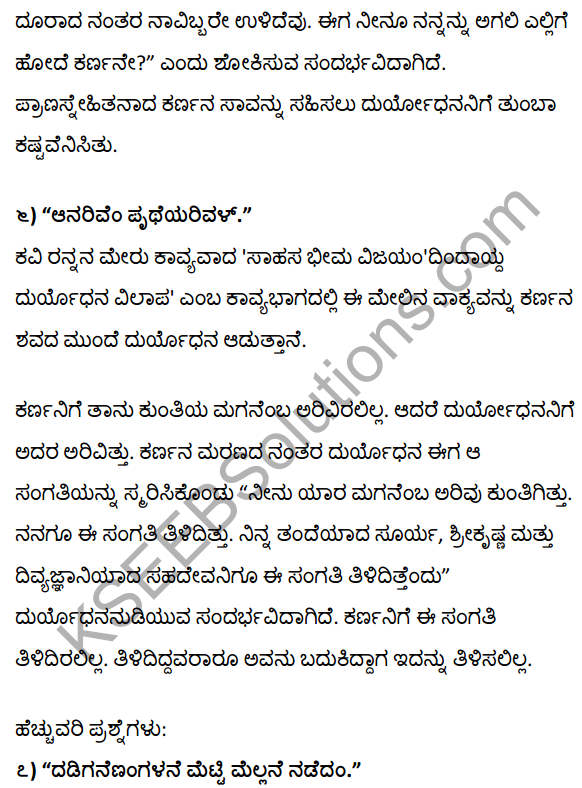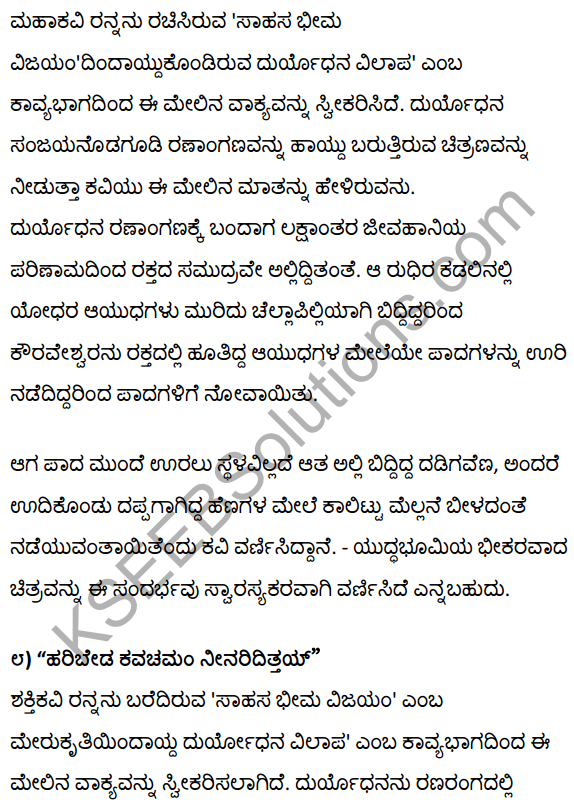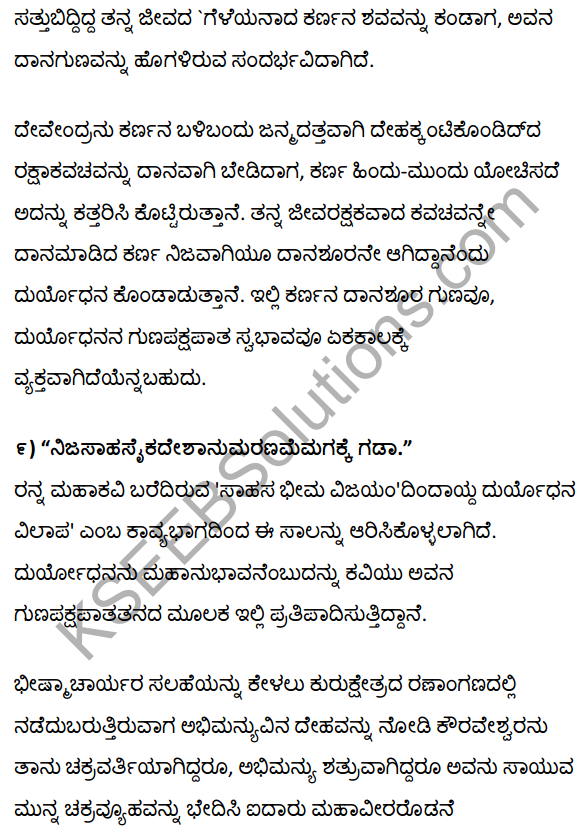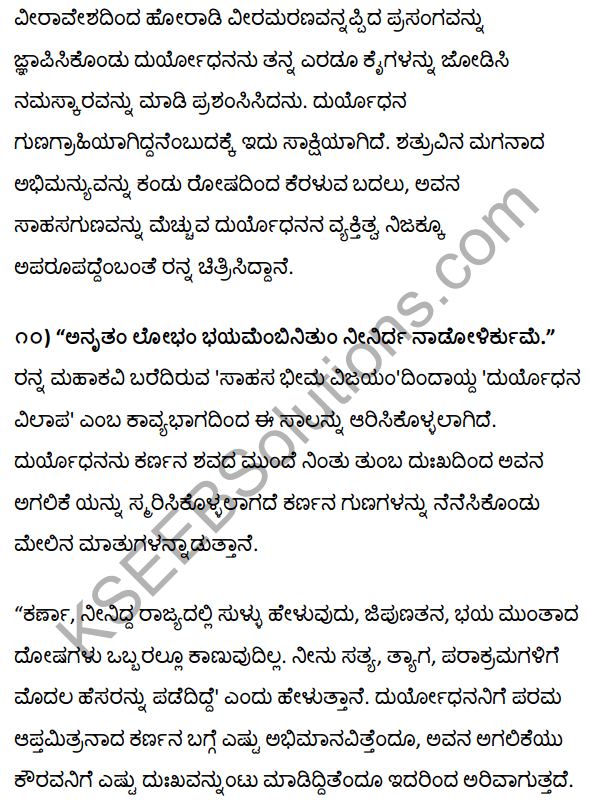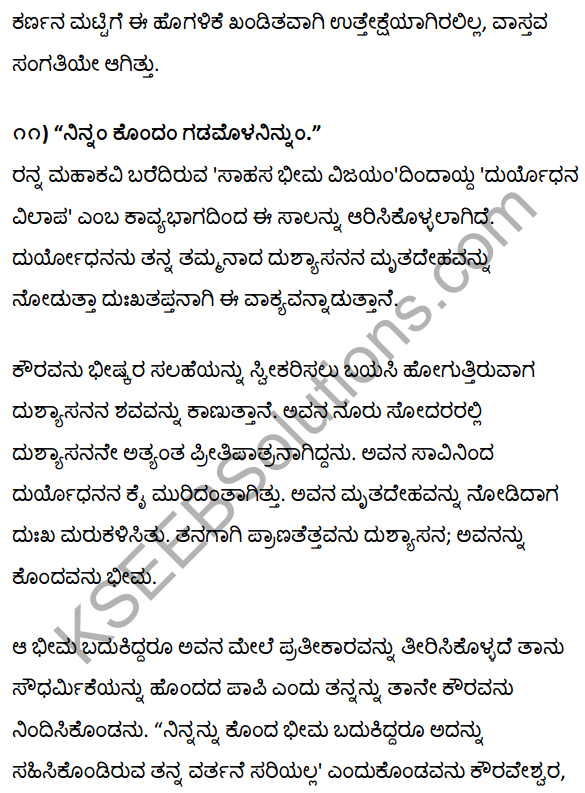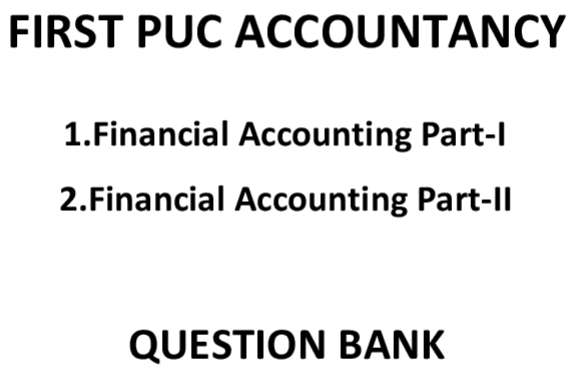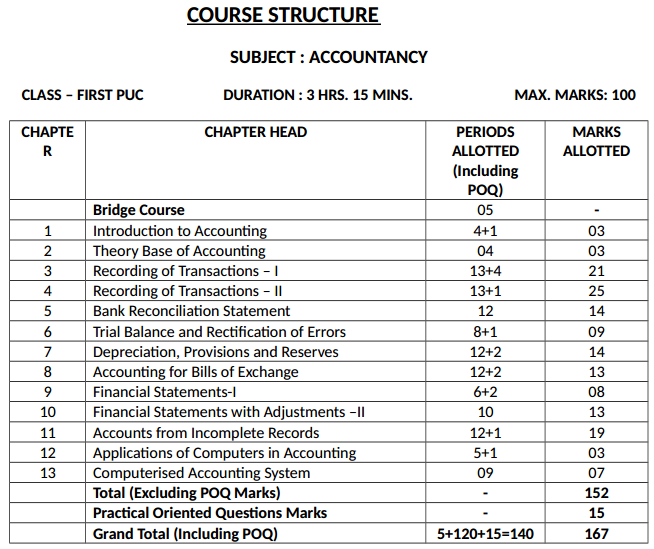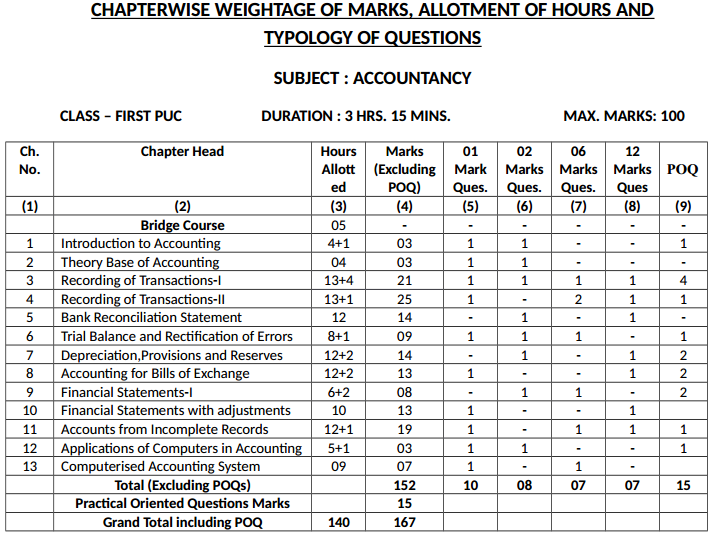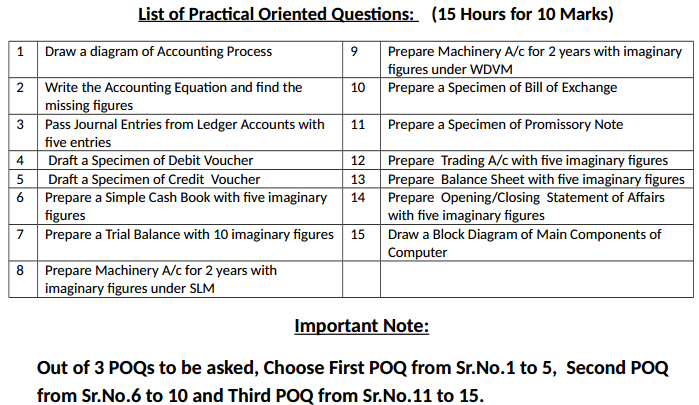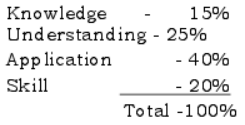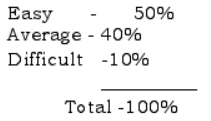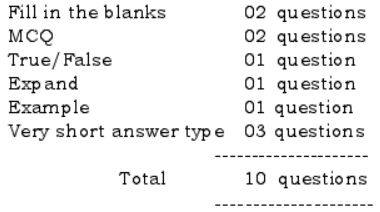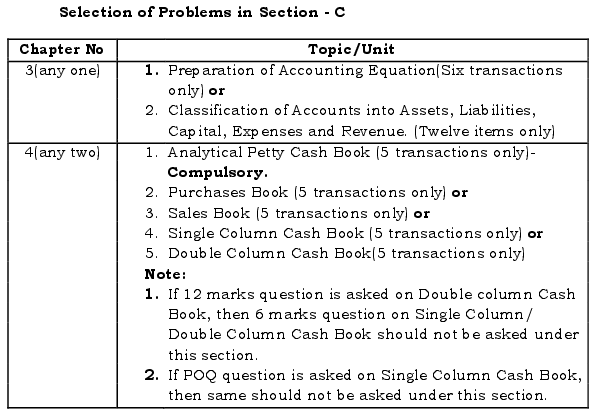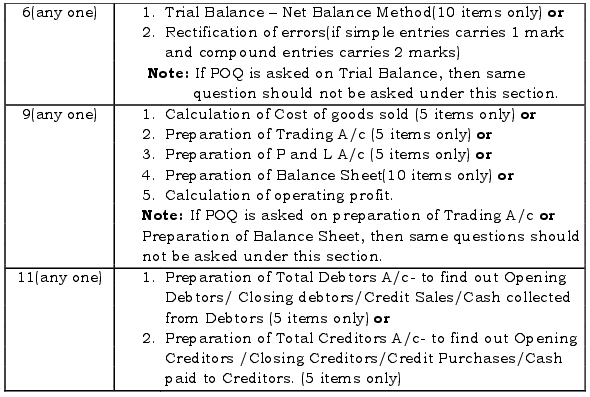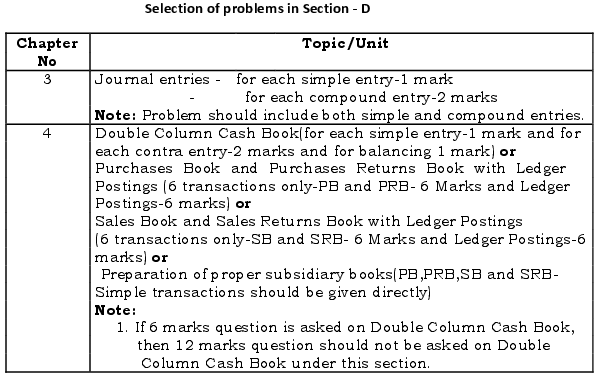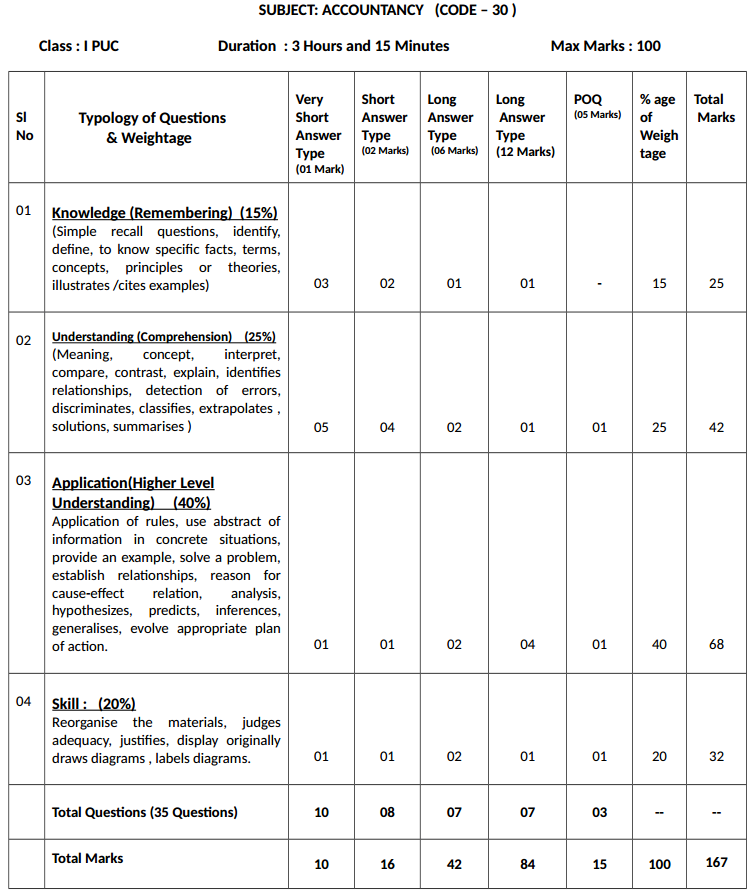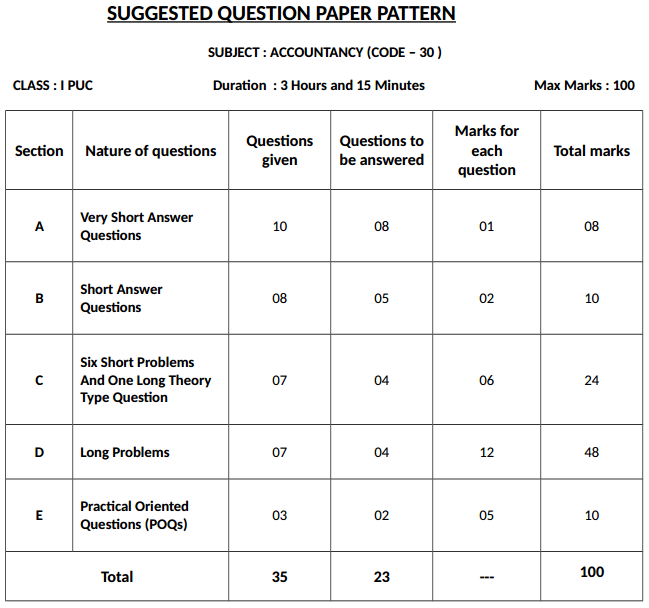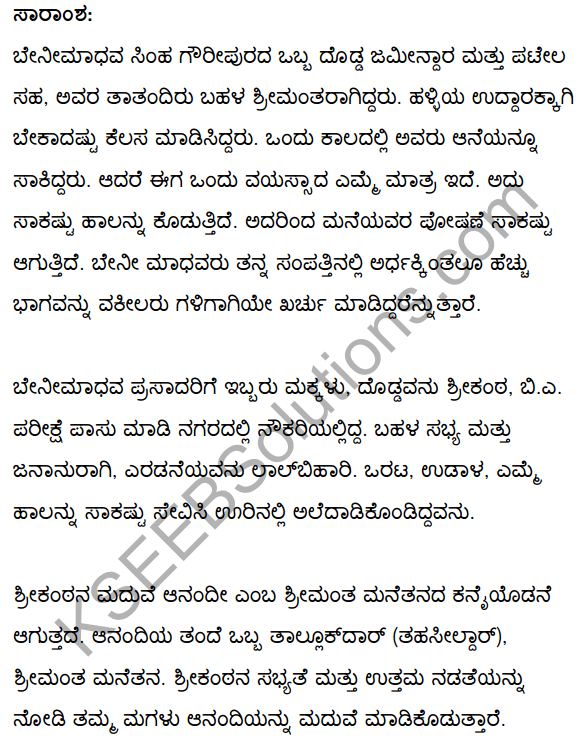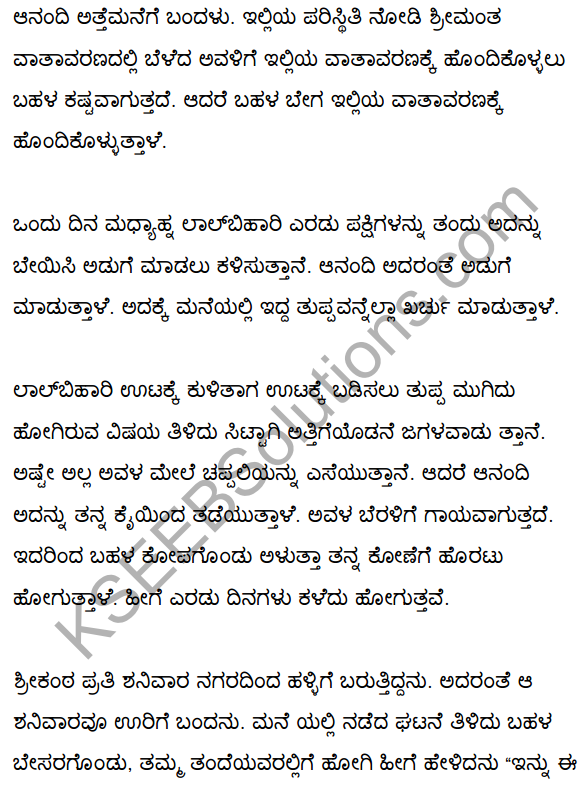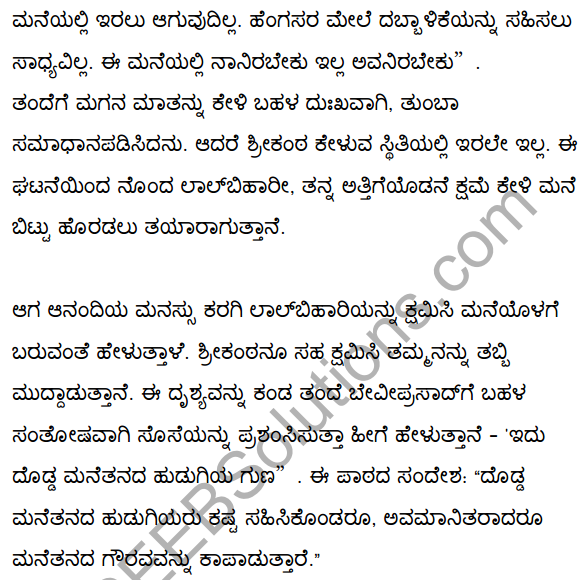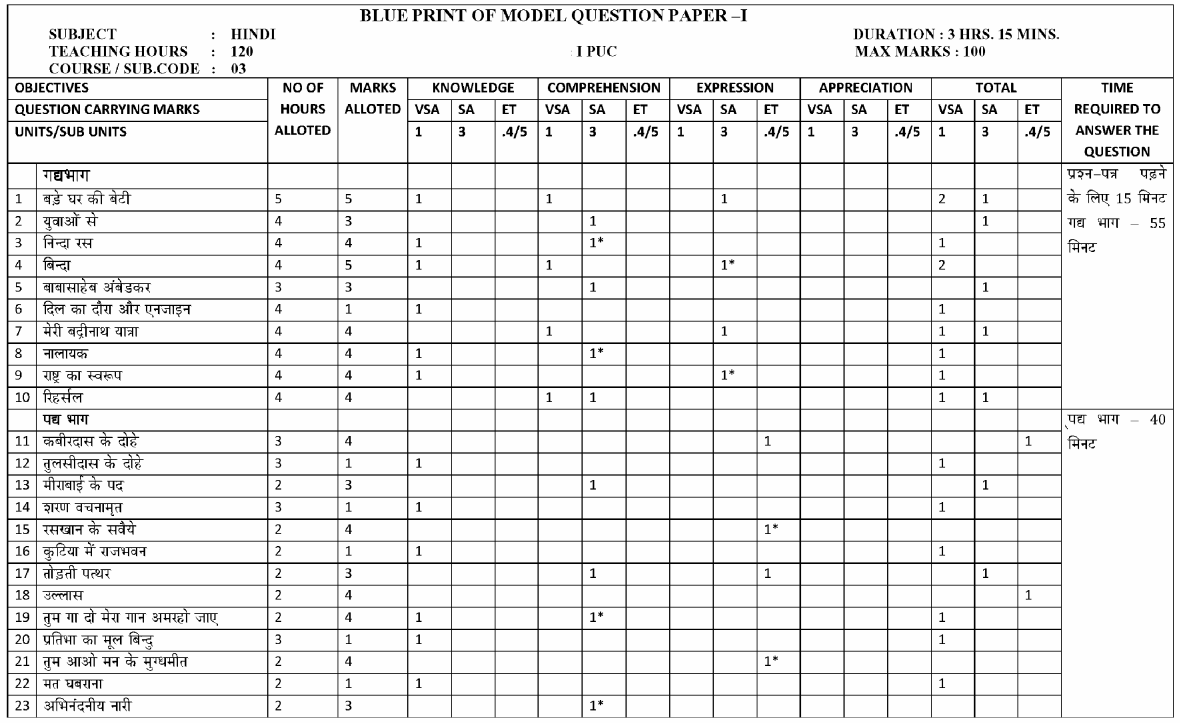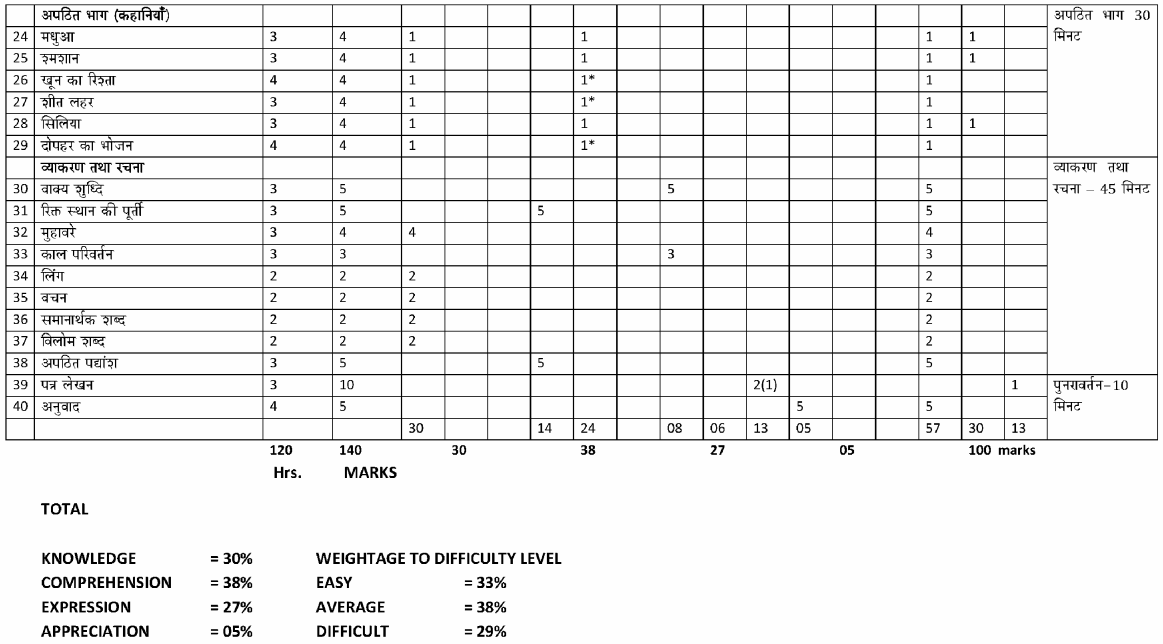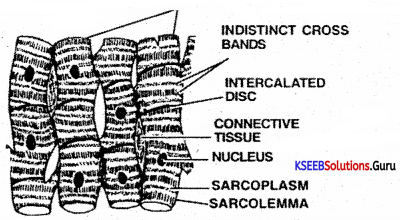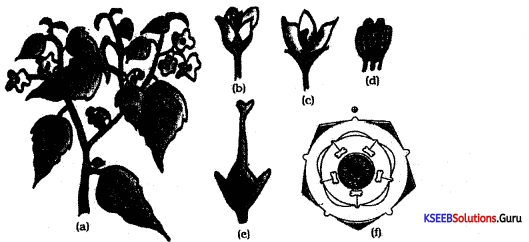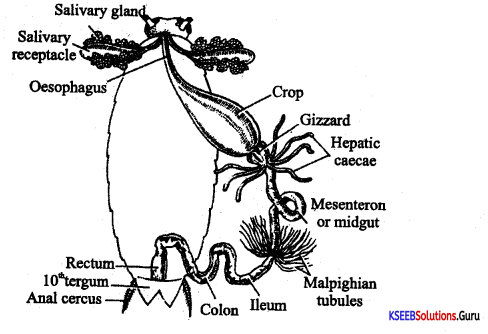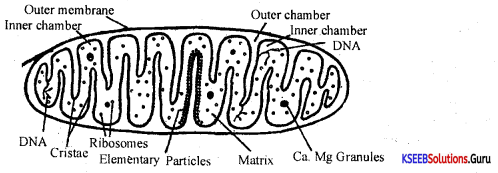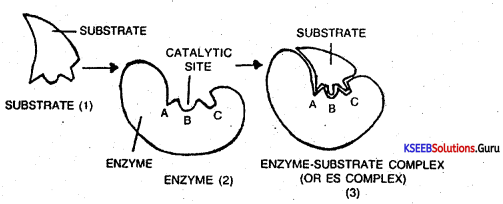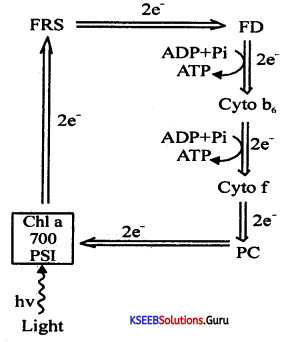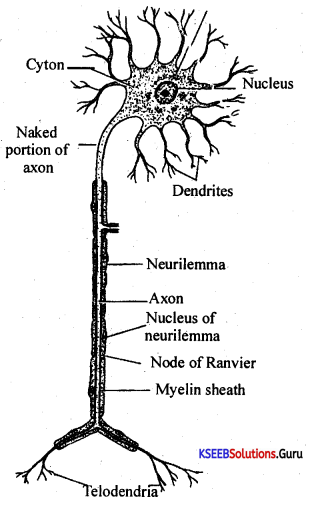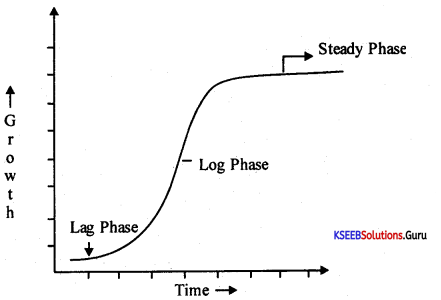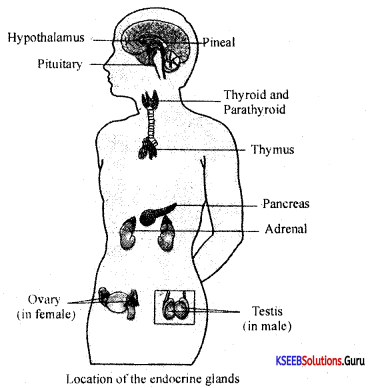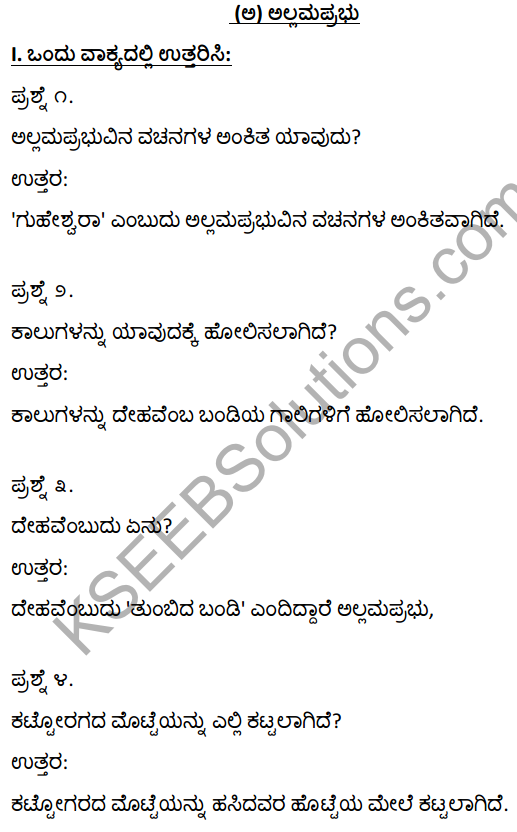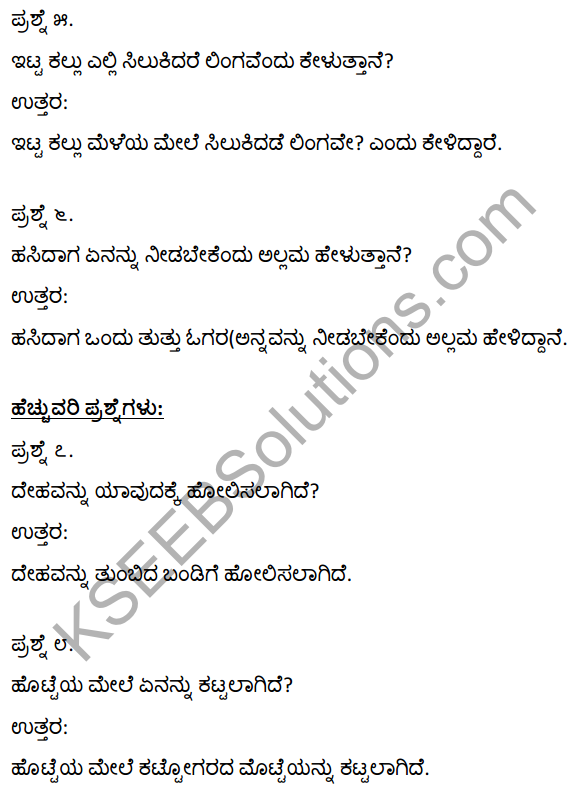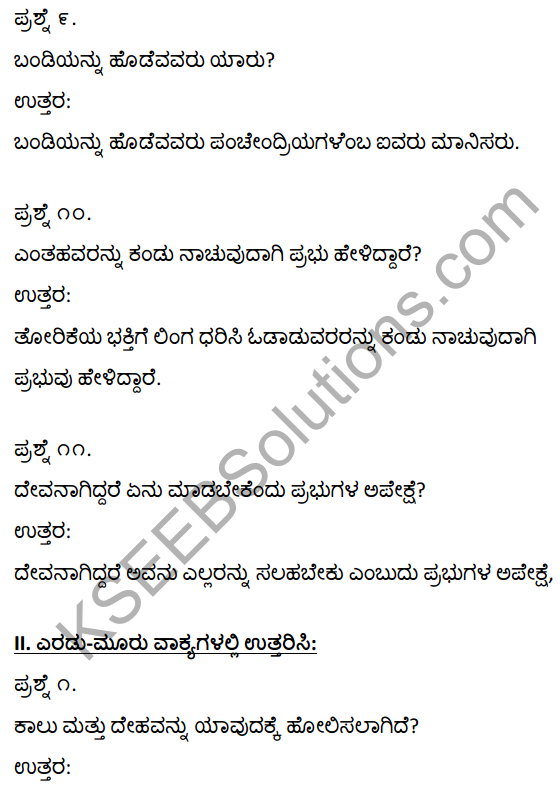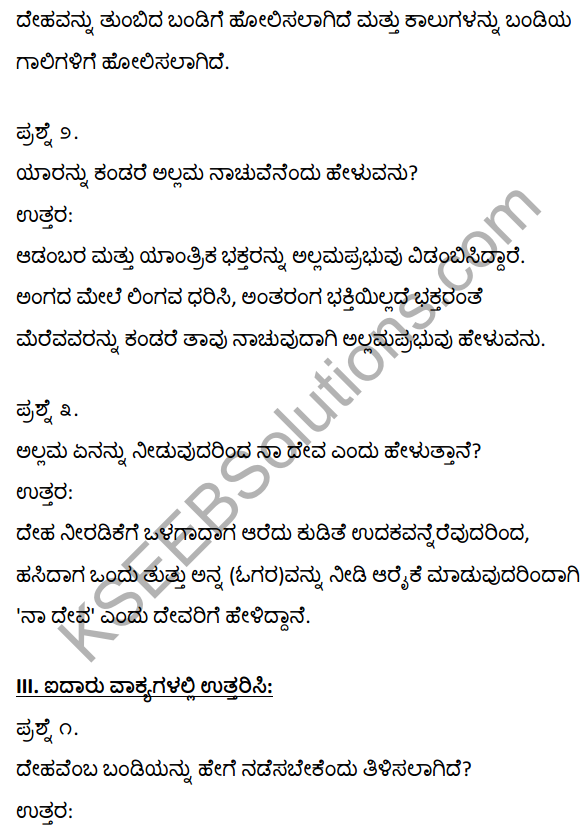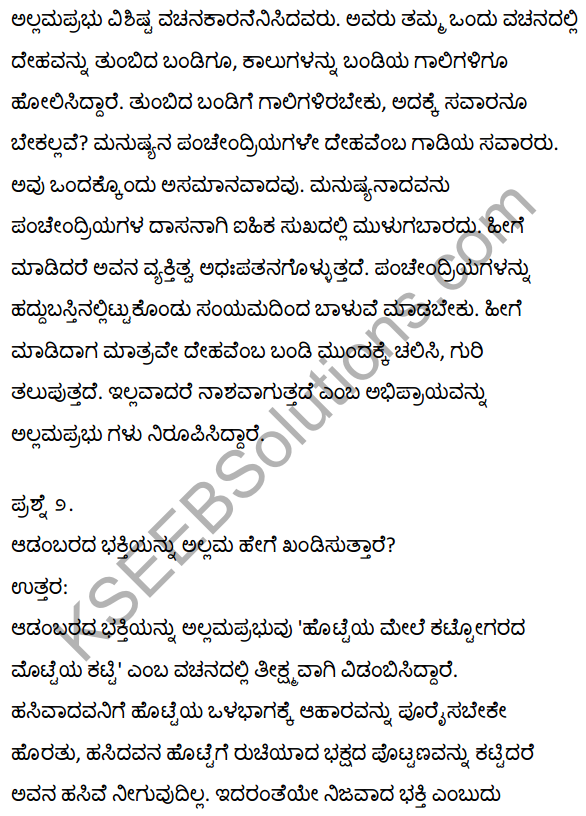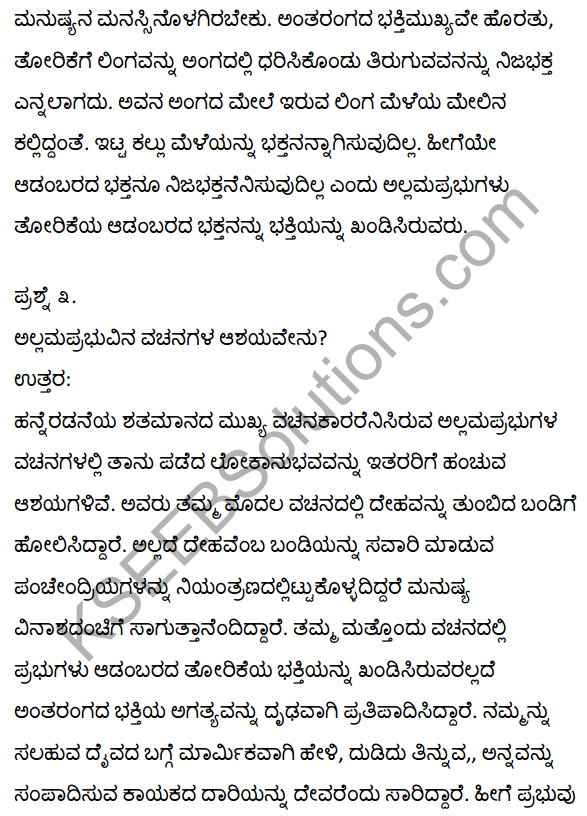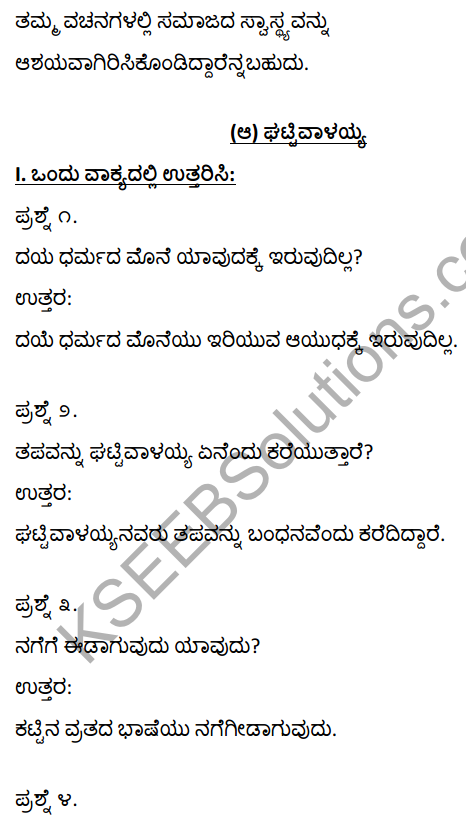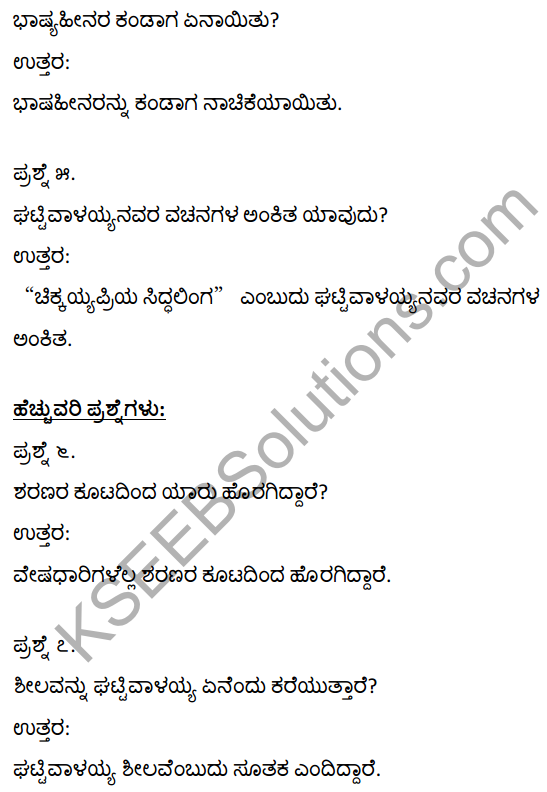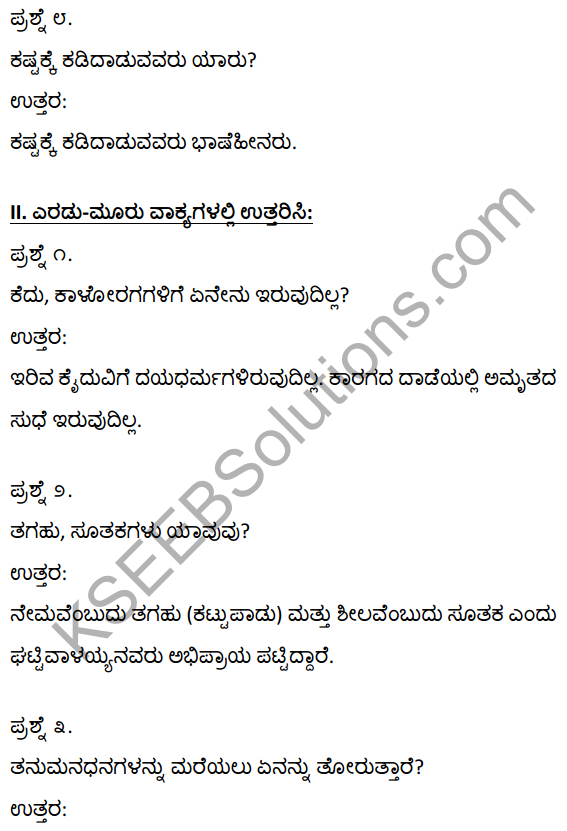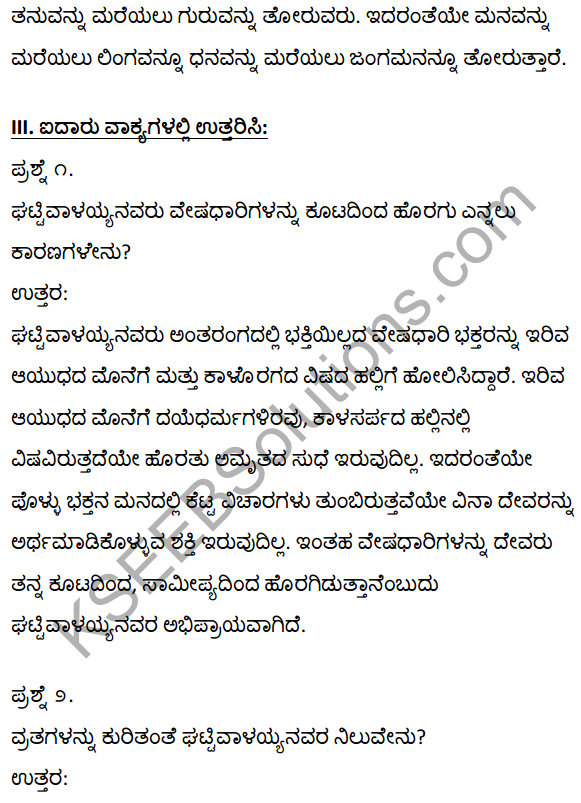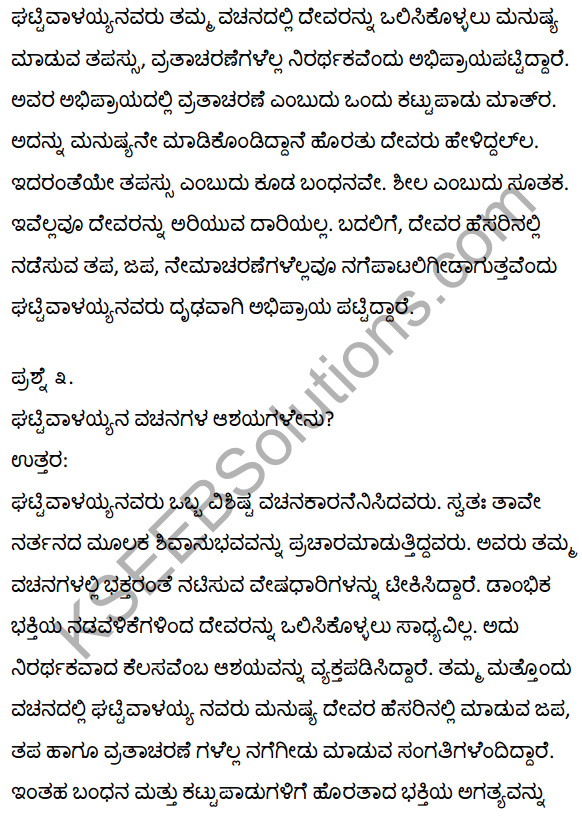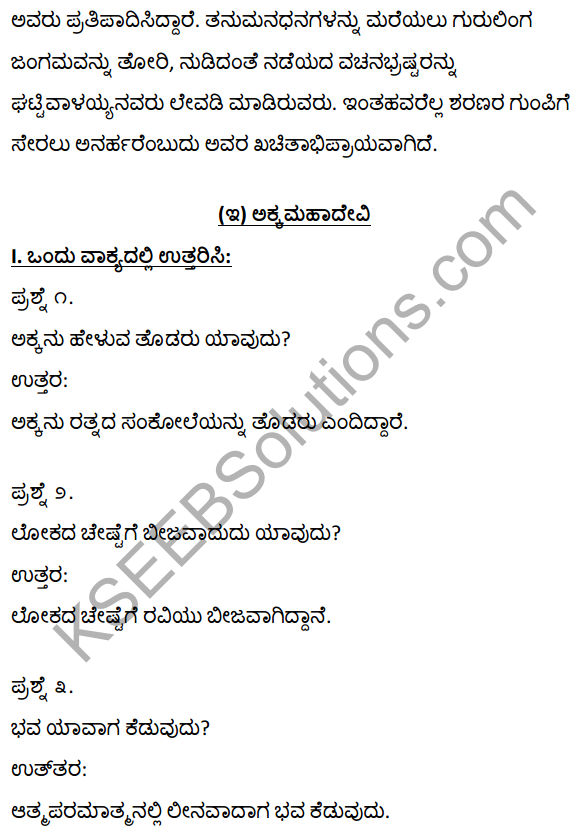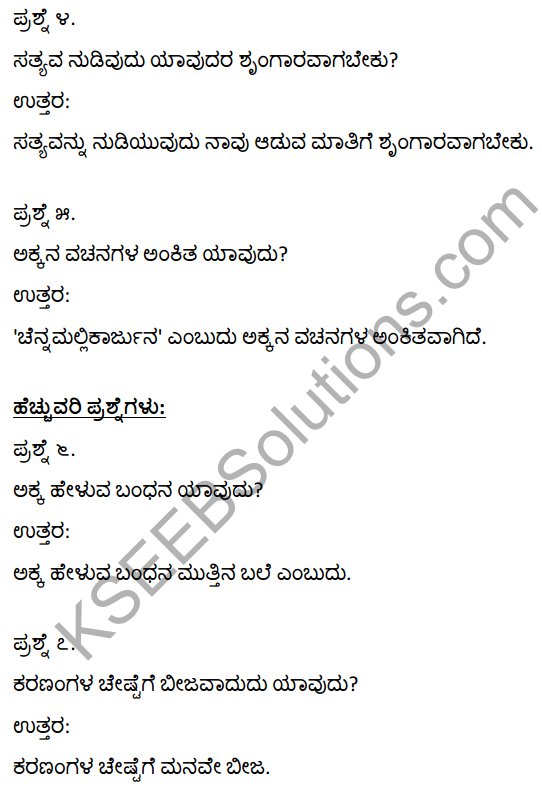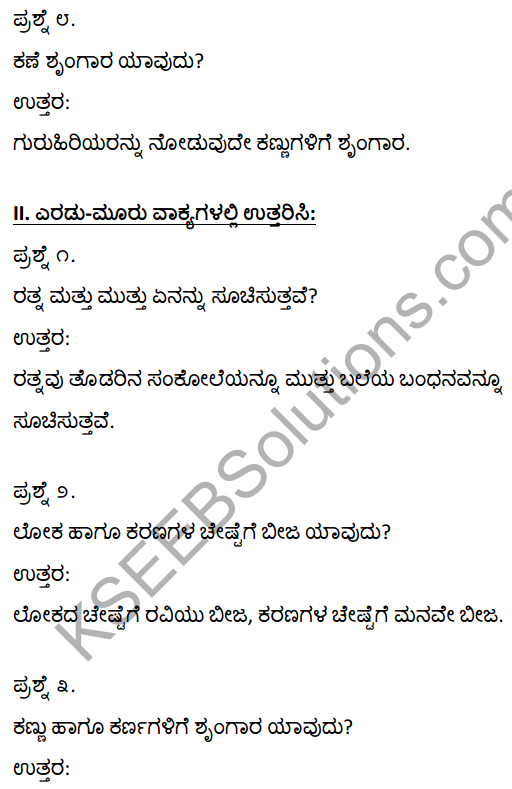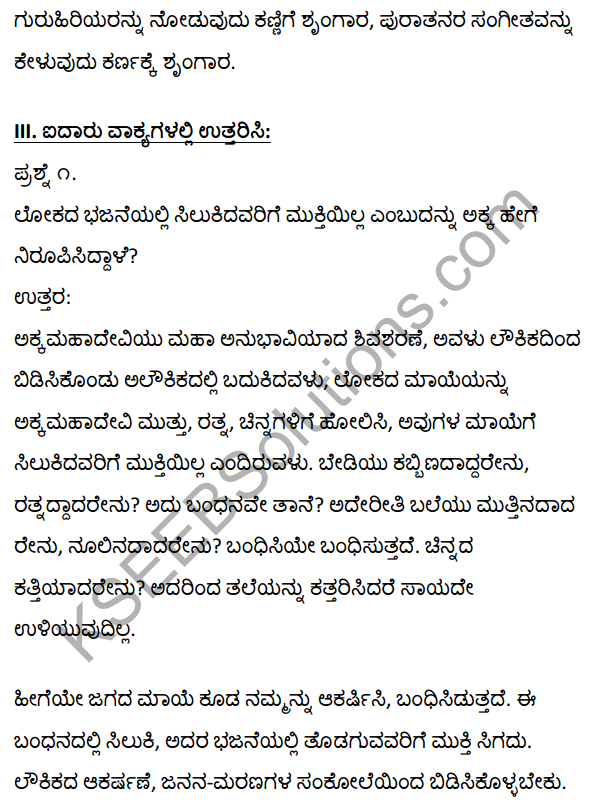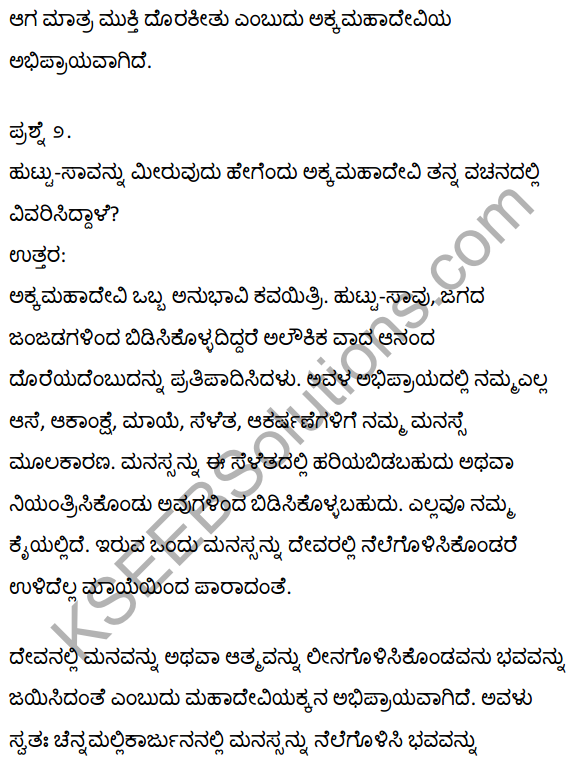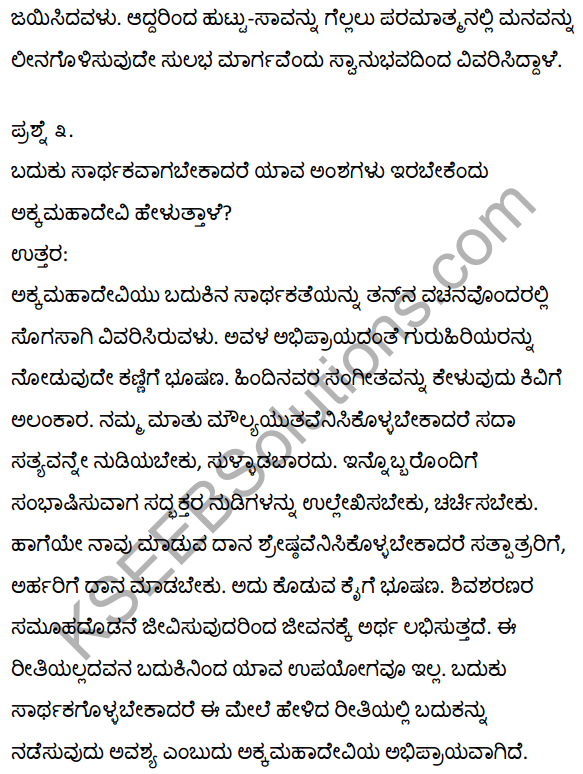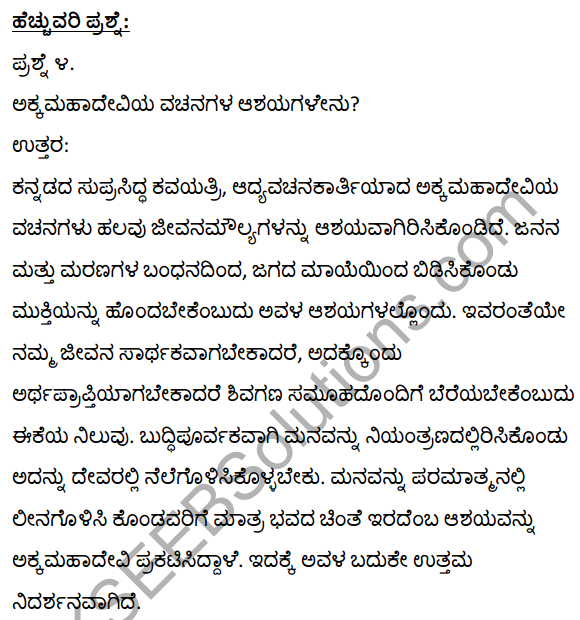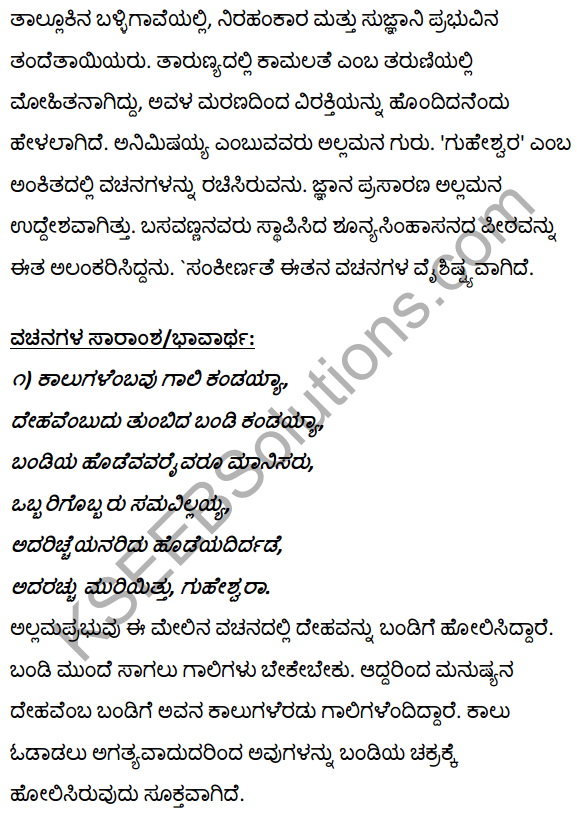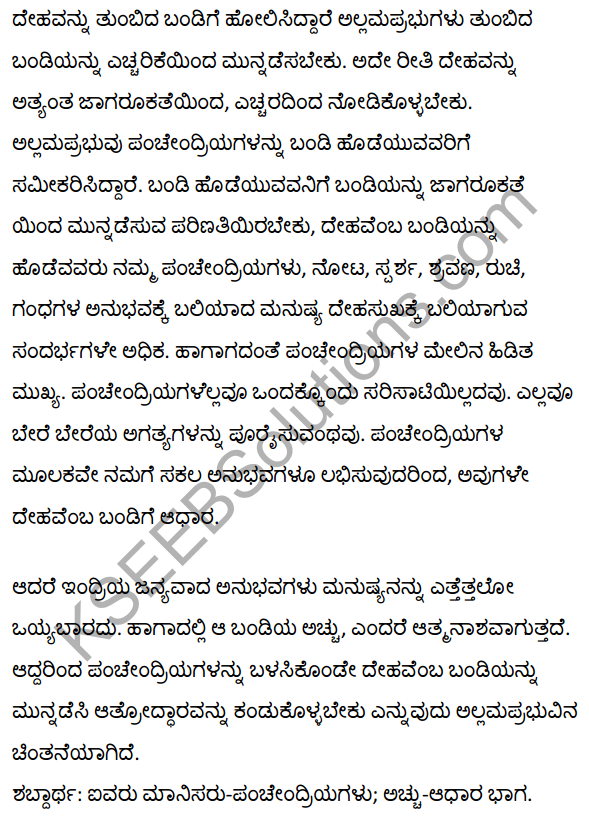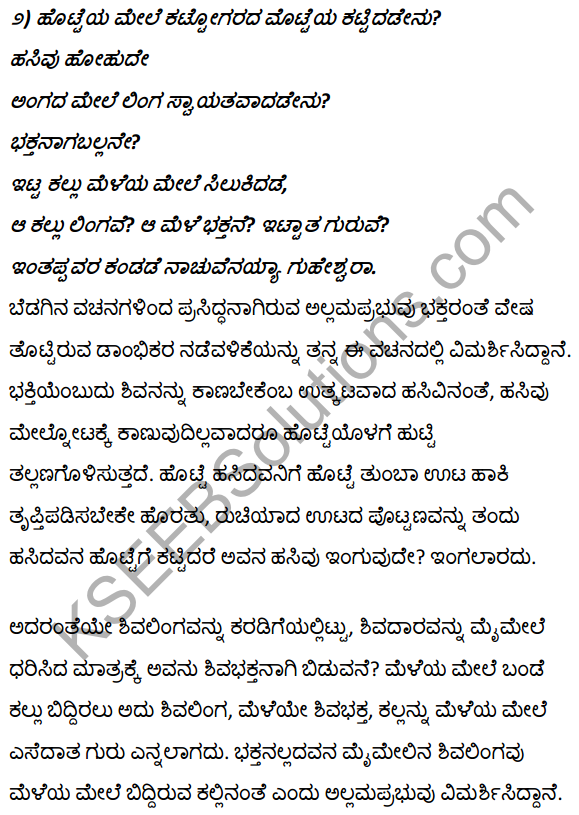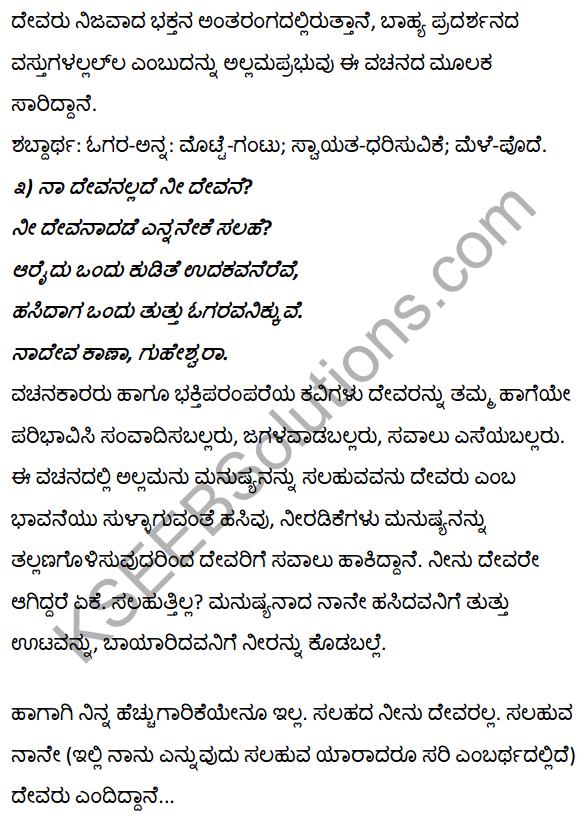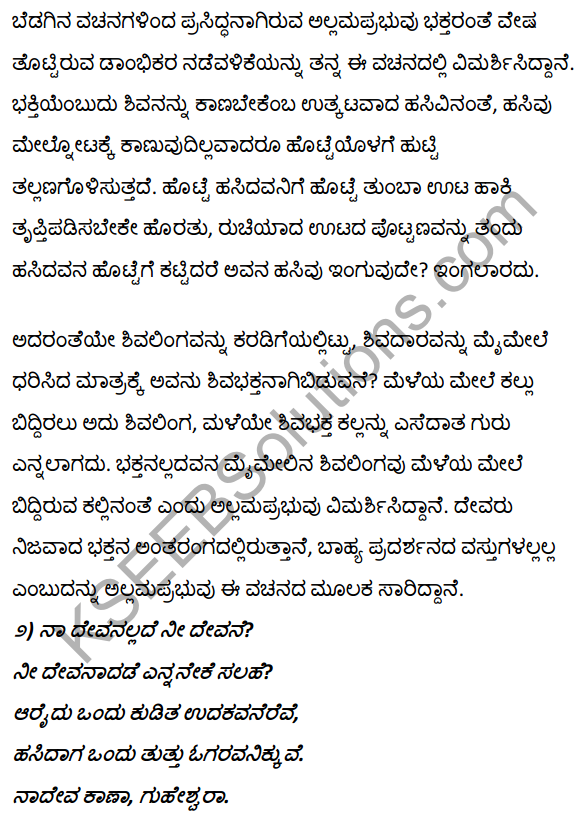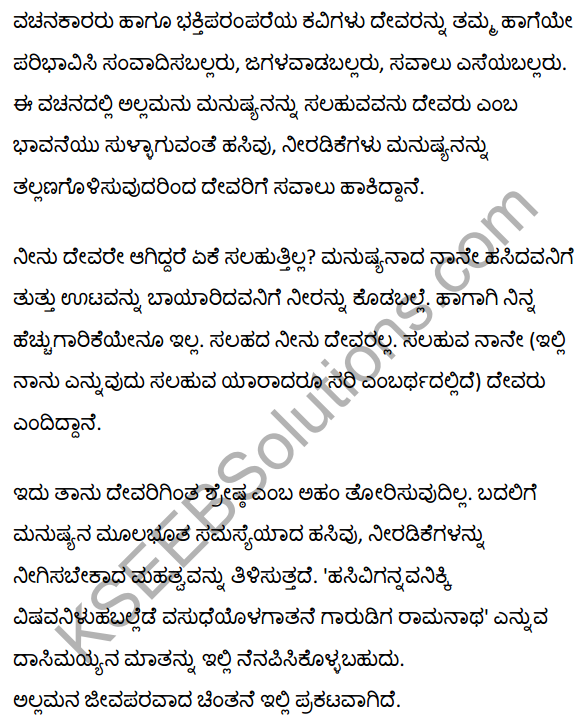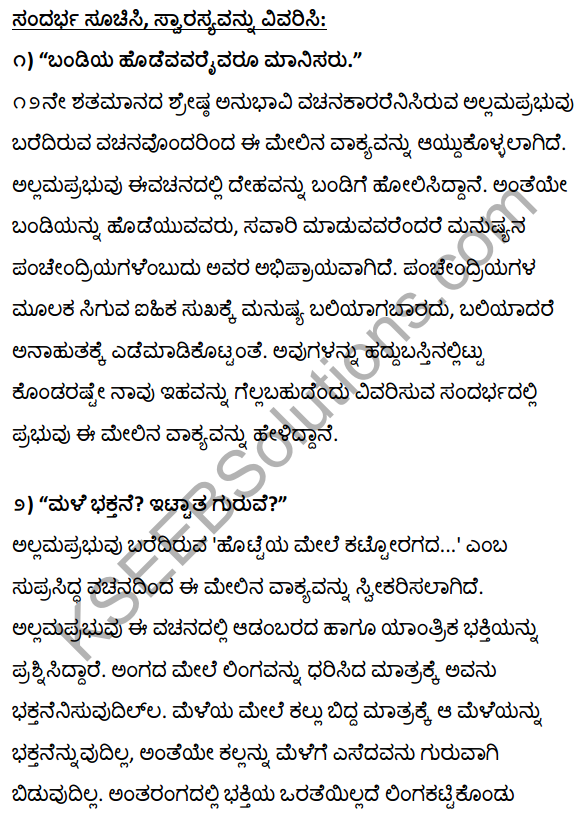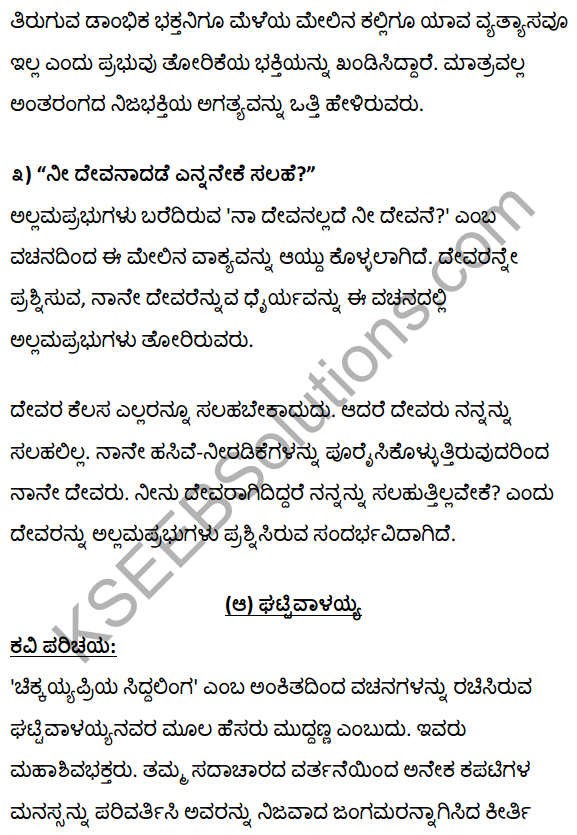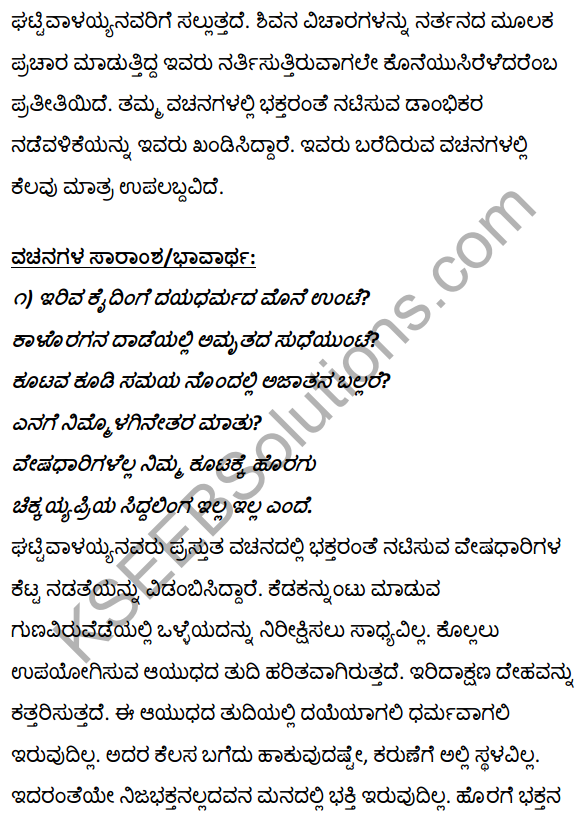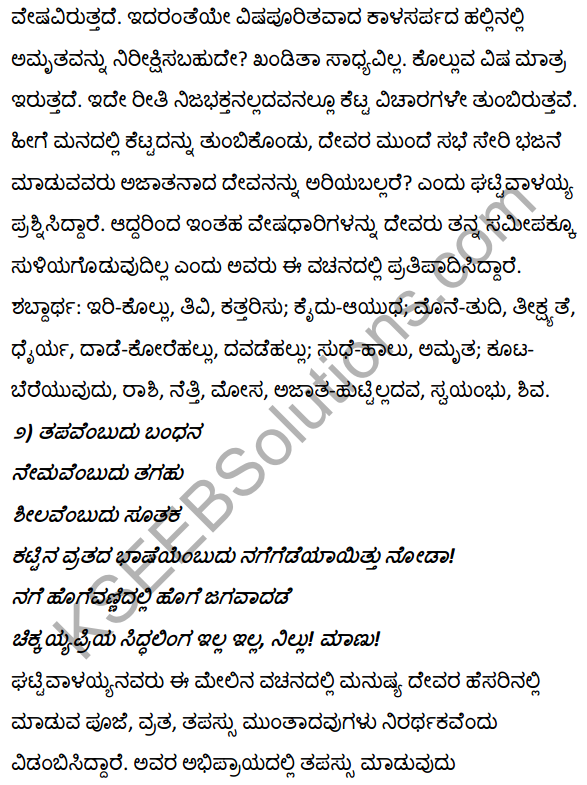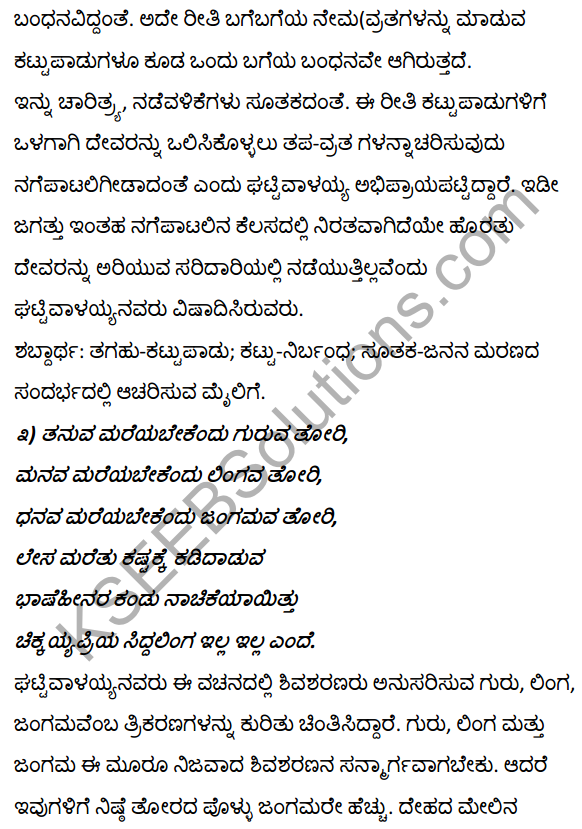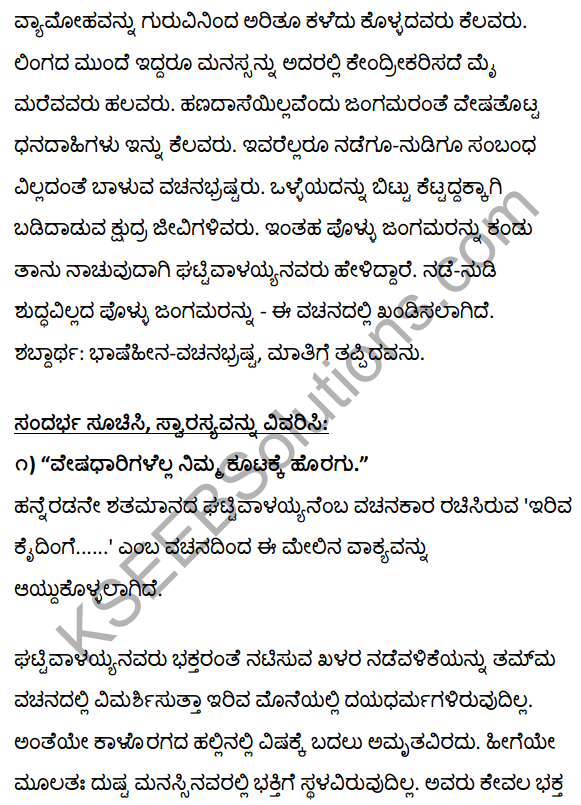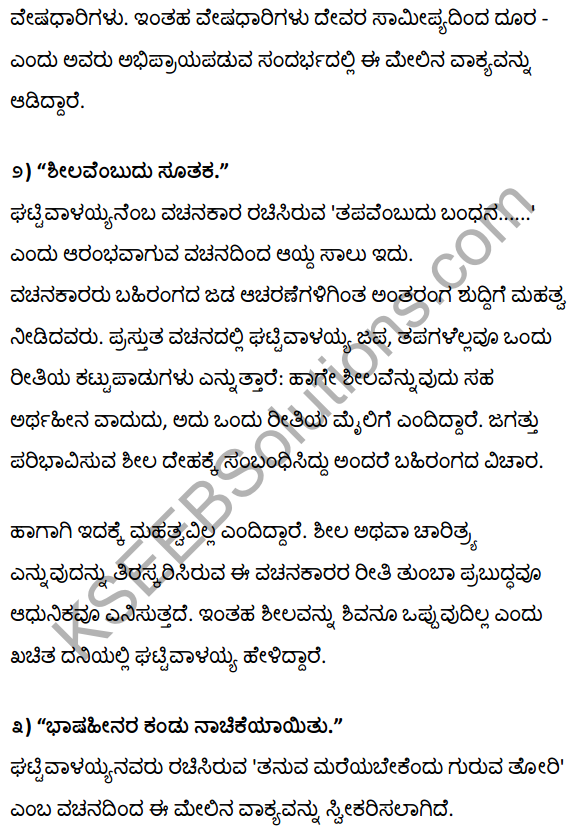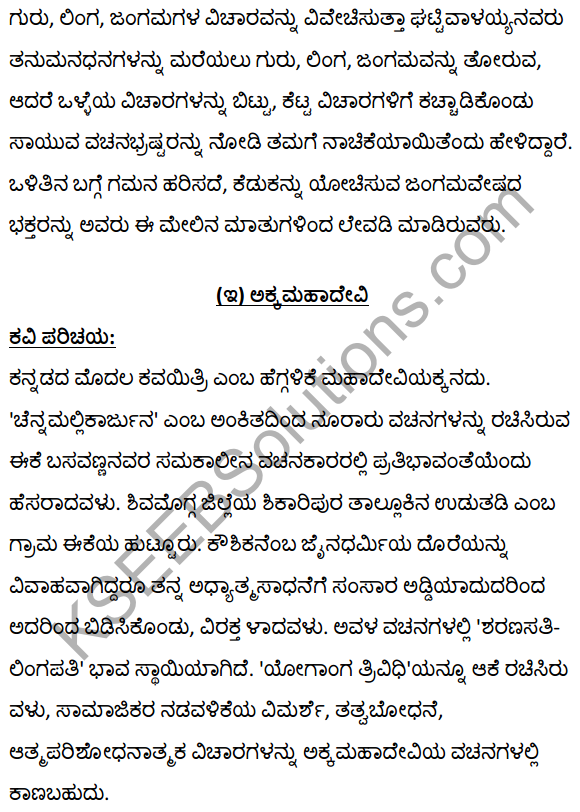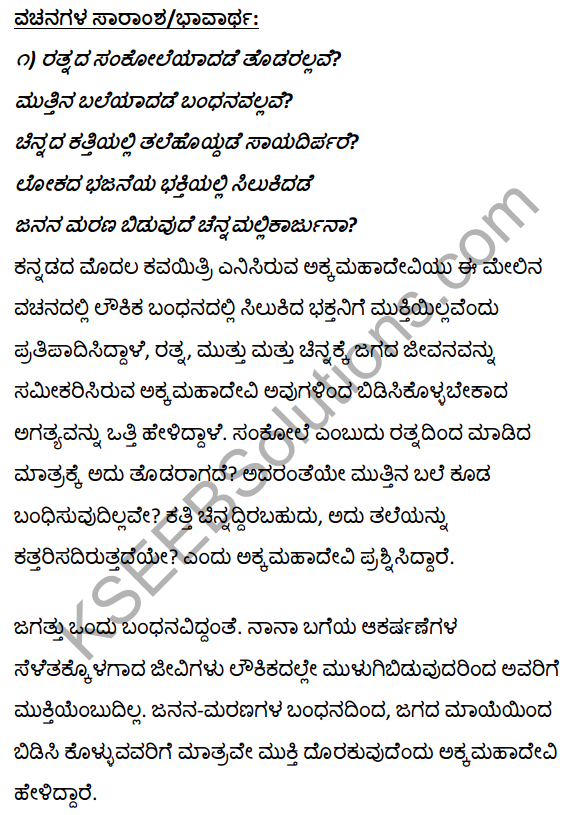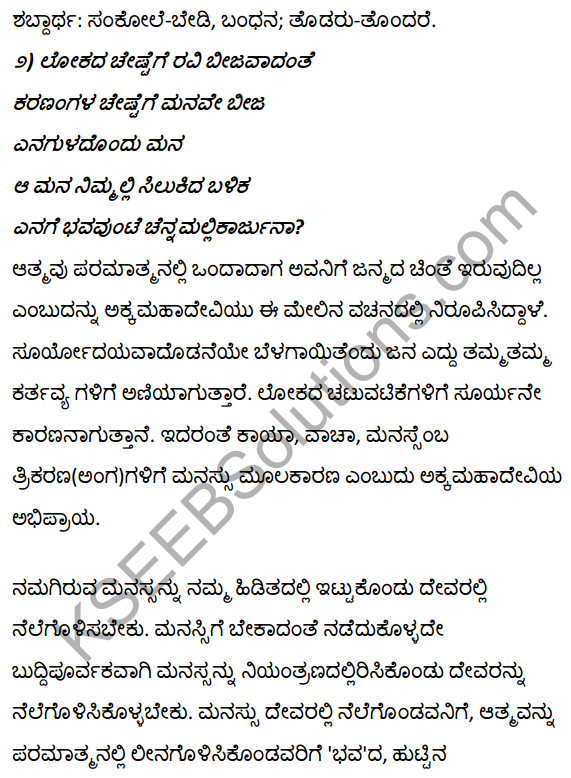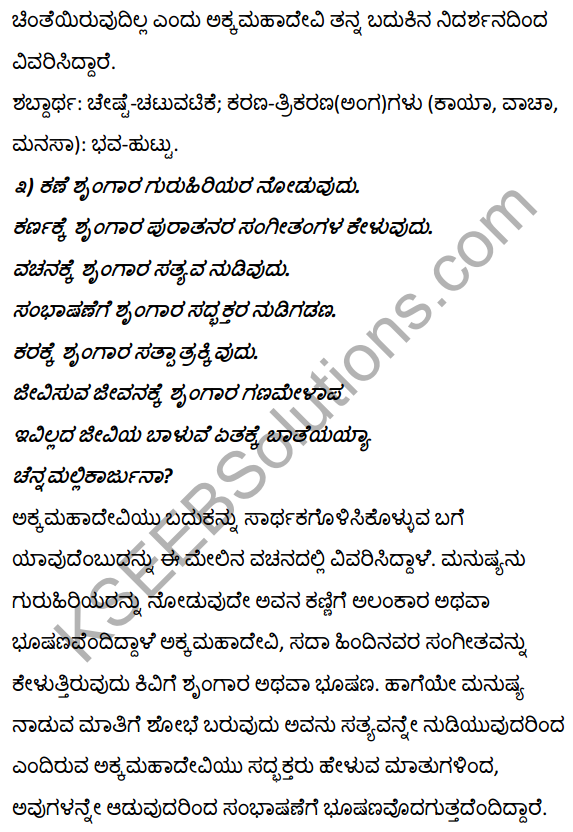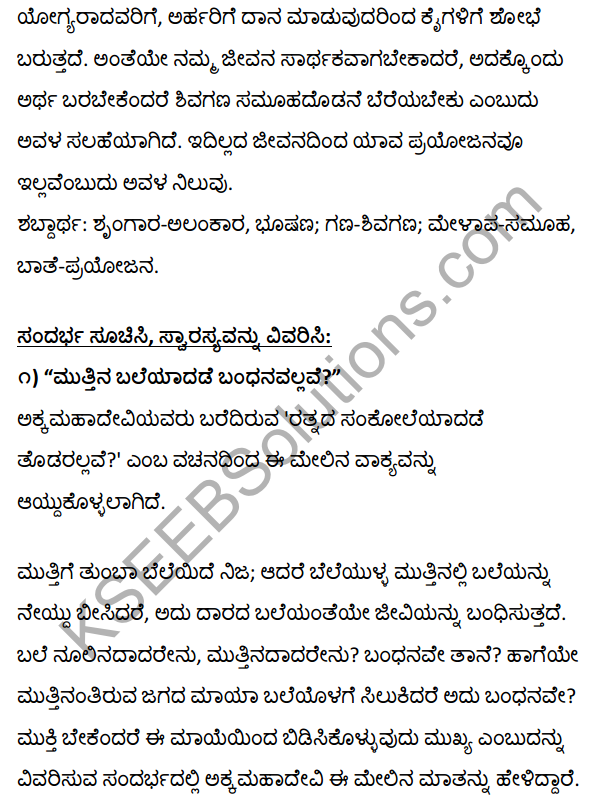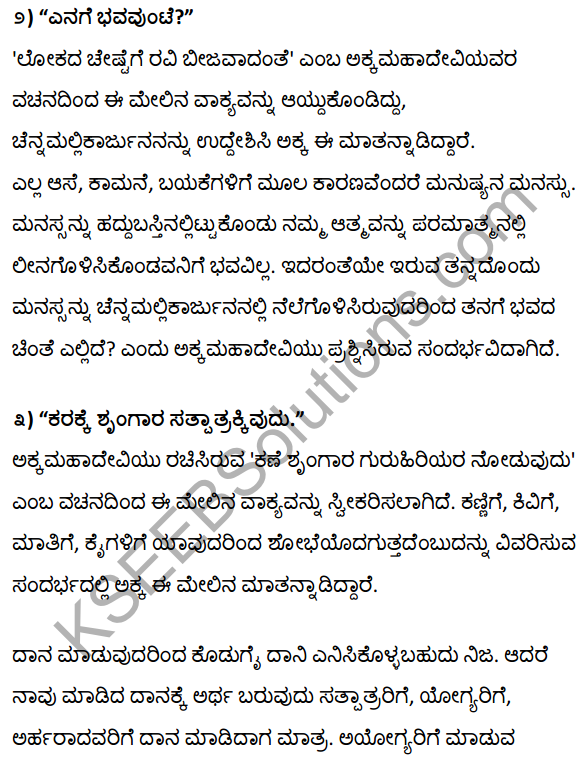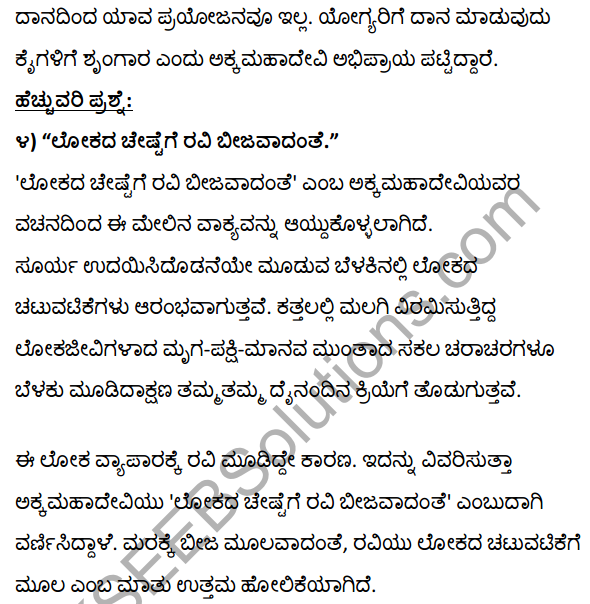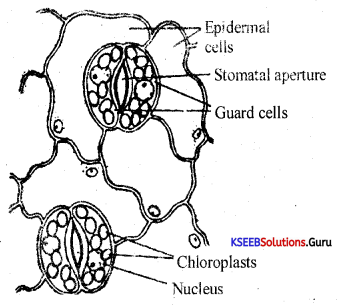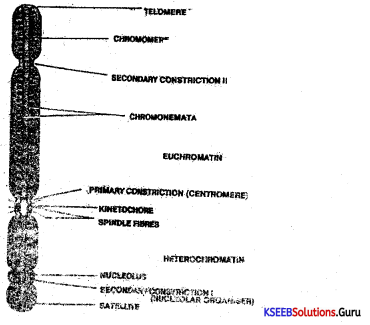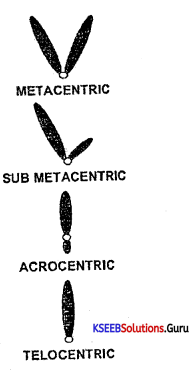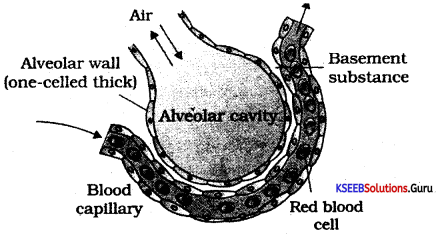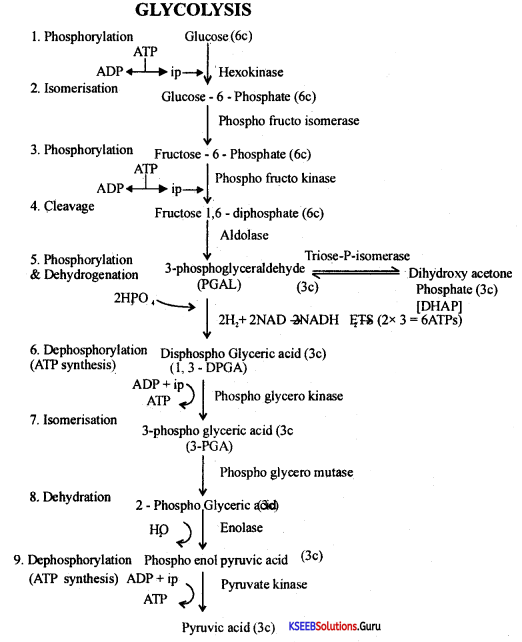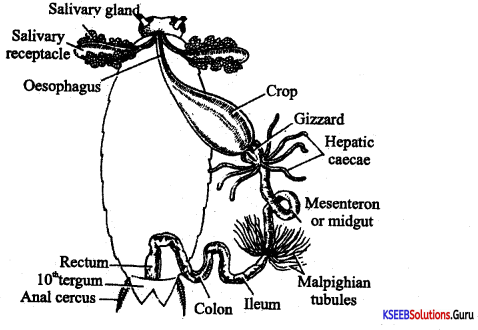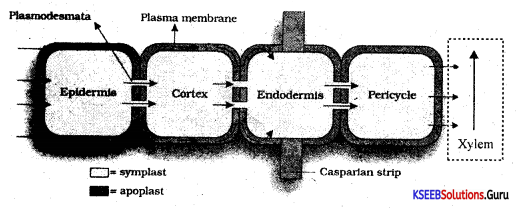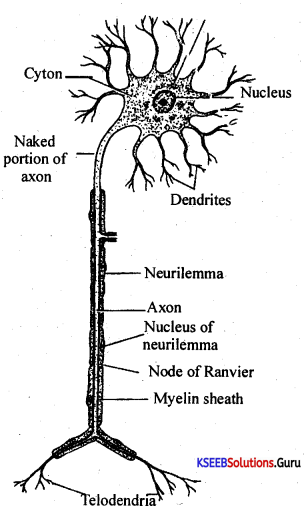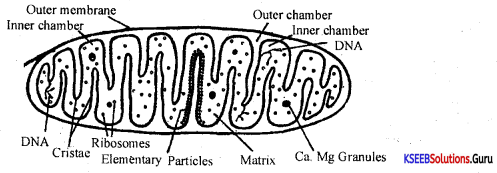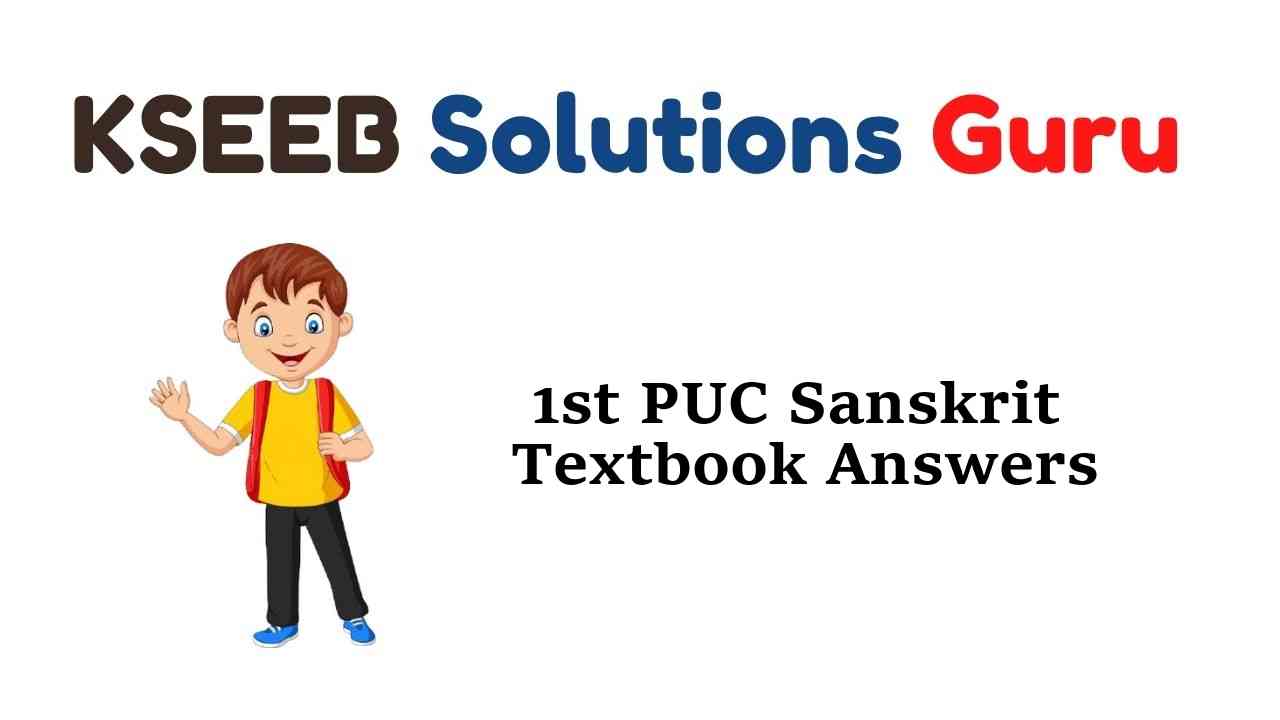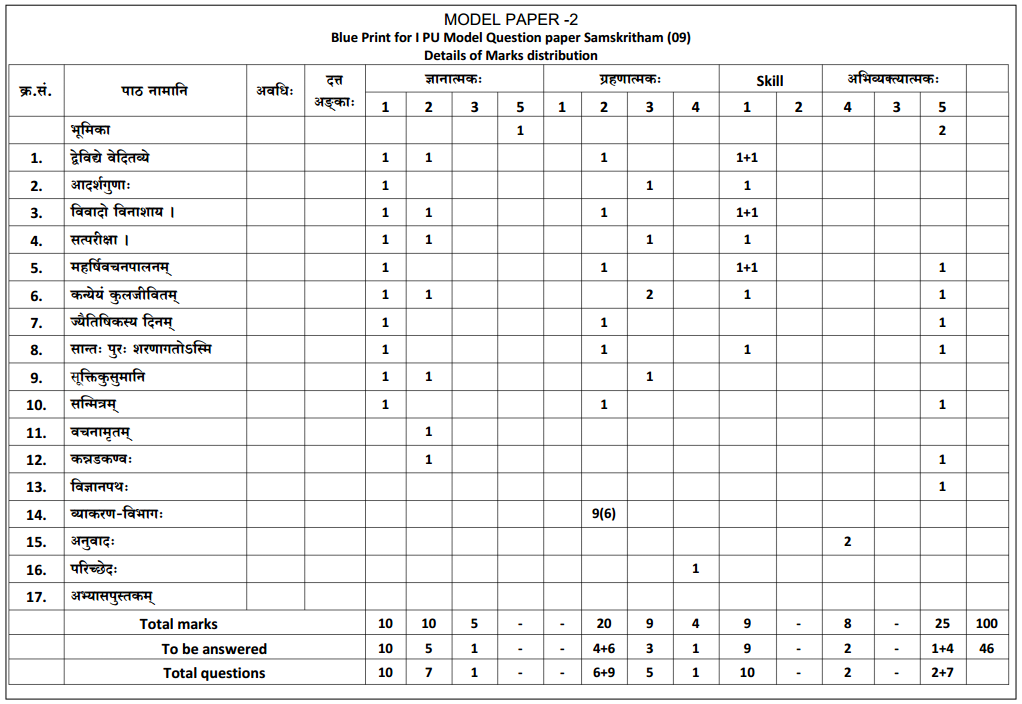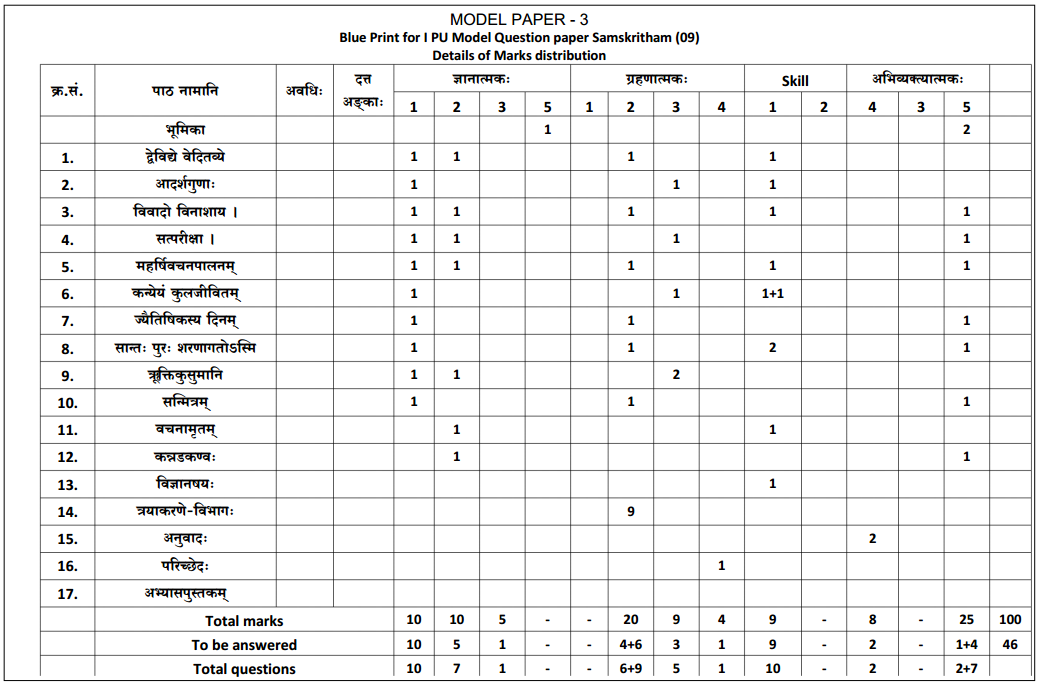You can Download Chapter 7 मेरी बद्रीनाथ यात्रा Questions and Answers Pdf, Notes, Summary, 1st PUC Hindi Textbook Answers, Karnataka State Board Solutions help you to revise complete Syllabus and score more marks in your examinations.
Karnataka 1st PUC Hindi Textbook Answers Sahitya Vaibhav Chapter 7 मेरी बद्रीनाथ यात्रा
मेरी बद्रीनाथ यात्रा Questions and Answers, Notes, Summary
I. एक शब्द या वाक्यांश या वाक्य में उत्तर दीजिए:
Meri Badrinath Yatra Notes KSEEB Solution प्रश्न 1.
कालिदास ने हिमालय को क्या कहा है?
उत्तरः
कालिदास ने हिमालय को नगाधिराज कहा है।
Meri Badrinath Yatra KSEEB Solution प्रश्न 2.
यात्रा के नियम के अनुसार लेखक पहले कहाँ गये?
उत्तरः
यात्रा के नियम के अनुसार लेखक पहले केदारनाथ गए।
Meri Badrinath Yatra Question Answer KSEEB Solution प्रश्न 3.
केदारनाथ की शीत-ऋतु की राजधानी का नाम क्या है?
उत्तरः
केदारनाथ की शीत-ऋतु की राजधानी का नाम उषीमठ हैं।
Meri Badrinath Ki Yatra KSEEB Solution प्रश्न 4.
सबसे ऊँचे स्थान पर बना हुआ मंदिर कौन-सा है?
उत्तरः
सबसे ऊँचे स्थान पर बना हुआ मंदिर तुंगनाथ है।
प्रश्न 5.
आठ वर्ष की प्यारी बच्ची का नाम क्या है?
उत्तरः
आठ वर्ष की प्यारी बच्ची का नाम संध्या है।
प्रश्न 6.
जोषीमठ से बद्रीनाथ कितने मील की दूरी पर है?
उत्तरः
जोषीमठ से बद्रीनाथ केवल 19 मील की दूरी पर है।
प्रश्न 7.
किस पेड़ के नीचे बैठकर प्रतिभापुंज शंकर ने उपनिषदों पर टीकाएँ लिखी थीं?
उत्तरः
कीमू अर्थात् शहतूत के पेड़ के नीचे बैठकर प्रतिभापुंज शंकर ने उपनिषदों पर टीकाएँ लिखी थी।
प्रश्न 8.
बद्रीनारायण मंदिर कितने फुट की ऊँचाई पर है?
उत्तरः
बद्रीनारायण मंदिर 10,480 फुट की ऊँचाई पर है।
अतिरिक्त प्रश्नः
प्रश्न 9.
‘मेरी बद्रीनाथ यात्रा’ – इस यात्रावर्णन के लेखक कौन हैं?
उत्तरः
‘मेरी बद्रीनाथ यात्रा’ – इस यात्रावर्णन के लेखक विष्णु प्रभाकर जी हैं।
प्रश्न 10.
तुंगनाथ शिखर कितने फुट ऊँचा है?
उत्तरः
तुंगनाथ शिखर 12,080 फुट ऊँचा है।
प्रश्न 11.
बद्रीनाथ घाटी में किस नदी का रूपजाल है?
उत्तरः
बद्रीनाथ घाटी में अलकनंदा नदी का रूपजाल है।
प्रश्न 12.
गरुड़-गंगा से पत्थर ले जाने वाले को किसका डर नहीं रहता?
उत्तरः
गरुड़-गंगा से पत्थर ले जाने वाले को साँपों का डर नहीं रहता है।
प्रश्न 13.
किस पेड़ के नीचे बैठकर प्रतिभा-पुंज शंकर ने उपनिषदों पर टीकाएँ लिखी थी?
उत्तरः
कीमू अर्थात् शहतूत के पेड़ के नीचे बैठकर प्रतिभा-पुंज शंकर ने उपनिषदों पर टीकाएँ लिखी थीं।
प्रश्न 14.
पांडुराजा द्वारा बसाई गई बस्ती कौन-सी है?
उत्तरः
पांडुराजा द्वारा बसाई गई बस्ती पांडुकेश्वर है।
प्रश्न 15.
बदरी किस फल को कहते हैं?
उत्तरः
बदरी बेरी (बेर) के फल को कहते हैं।
प्रश्न 16.
विशालपुरी किस नदी के दाहिनी किनारे पर बसी है?
उत्तरः
विशालपुरी अलकनंदा नदी के दाहिनी किनारे पर बसी है।
प्रश्न 17.
लोकपाल किन लोगों के तीर्थ-स्थान है?
उत्तरः
लोकपाल सिक्खों का तीर्थ-स्थान है।
प्रश्न 18.
विष्णु गंगा और अलकनंदा के संगम स्थान पर क्या है?
उत्तरः
विष्णु गंगा और अलकनंदा के संगम स्थान पर विष्णुप्रयाग है।
प्रश्न 19.
‘कीमू’ का अर्थ क्या है?
उत्तरः
‘कीमू’ का अर्थ शहतूत है।
II. निम्नलिखित प्रश्नों के उत्तर लिखिएः
प्रश्न 1.
हिमालय की विशेषता का वर्णन कीजिए।
उत्तरः
हिमालय को कालिदास ने ‘नगाधिराज’ कहा है। यह विश्व का श्रेष्ठ एवं ऊँचा पर्वत है। बर्फीला नजारा देखते ही बनता है। इसके अंचल से कितनी ही नदियाँ अलख जगाते हुए, कलकल निनाद करते हुए बहती हैं। कस्तूरी मृग अपनी नाभि में सुगन्ध लिए यहीं घूमते हैं। देवदारू, चीनार आदि वृक्षों की छटा देखते ही बनती है। रंग-बिरंगे पक्षियों का कलरव सुनाई पड़ता है। इस प्रकार हिमालय का प्राकृतिक सौन्दर्य हर किसी को अपनी ओर आकर्षित करके किसी को कवि या किसी को दार्शनिक भी बना देता है।
प्रश्न 2.
बद्रीनाथ यात्रा में लेखक और उनके साथियों की दिनचर्या लिखिए।
उत्तरः
लेखक और उनके साथी प्रतिदिन प्रातः तीन बजे उठते हैं। अपने बिस्तर समेटकर, नित्यकर्म पूरा करके, भारवाहकों को अपने सामान देकर आगे बढ़ते हैं। प्रतिदिन 12 से 18 मील यात्रा करते हैं। बद्री विशाल की जयकार करते हुए, हँसी-मजाक की बातें करते हुए, आवश्यकतानुसार अल्पाहार लेते हुए, अगले पड़ाव तक पहुंचते हैं।
प्रश्न 3.
तुंगनाथ शिखर के सौंदर्य के संबंध में लेखक ने क्या कहा है?
उत्तरः
तुंगनाथ शिखर 12,080 फुट की ऊँचाई पर है। यद्यपि टेढ़ामेढ़ा उतार-चढ़ाव का रास्ता है, फिर भी थकान महसूस नहीं होती। गंगोत्री, यमुनोत्री, केदारनाथ, बद्रीनाथ, चौखंभा आदि रजत-शिखर सूर्य-प्रकाश में चमकते रहते हैं। हिम-शिखरों के दर्शनों का यात्री लाभ उठाते हैं। यहाँ की प्रकृति यात्रियों को मोह लेती है। शाम होने से पूर्व ही यहाँ कोहरा छा जाता है।
प्रश्न 4.
बद्रीनाथ की घाटी का चित्रण कीजिए।
उत्तरः
बद्रीनाथ की घाटी में केदारनाथ जैसा सौन्दर्य तो नहीं है, परन्तु अलकनंदा का रूपजाल जरूर है। यह नदी यहाँ उछल-कूद मचाती, गर्जन करती, जल-प्रपात बनाती आगे बढ़ती है। कहीं-कहीं बर्फीले-प्राकृतिक पुल देखने लायक होते हैं। नटखट धाराएँ अटखेलियाँ करती हुई, शोर मचाती हुई आगे बढ़ती हैं।
प्रश्न 5.
बद्रीनारायण मंदिर की विशेषता पर प्रकाश डालिए।
उत्तरः
अलकनंदा के दोनों ओर के पहाड़ नर-नारायण कहलाते हैं। कहा जाता है कि किसी जमाने में बद्रीनाथ में बेरी का वन था। बदरी को बेर कहा जाता है। यह मंदिर 10,480 फुट की ऊँचाई पर बना हुआ है। मंदिर की स्थापना आदि शंकराचार्य जी ने किया था। यह मंदिर नारायण मंदिर की गोद में बसा है। नीलकंठ के हिम-शिखर की छाया भी है। देश का अंतिम गाँव भी माना जाता है। यह मंदिर आकर्षण है- सरल भक्ति का, प्रकृति के वैभव का। बद्रीनारायण का मंदिर एक तीरथ धाम हैं।
अतिरिक्त प्रश्नः
प्रश्न 6.
बद्रीनाथ यात्रा में लेखक के दल का वर्णन कीजिए।
उत्तरः
लेखक के दल में भारत के विविध प्रांतों से आए श्रद्धालु थे। उसमें स्त्री और पुरुष, युवक और वृद्ध, वैष्णव और जैन, व्यापारी और विद्यार्थी, शासक और संपादक, प्रकाशक और लेखक, राजस्थानी, हिन्दी और मराठी भाषा-भाषी सभी शामिल थे।
प्रश्न 7.
एक वयोवृद्ध सज्जन कैसे हँसी का पात्र बन गया?
उत्तरः
लेखक के दल के एक वयोवृद्ध सज्जन चिल्ला उठे, ‘अरे बिच्छू-बिच्छू’। सभी लोग यह सुनकर चौंक गए। वृद्ध घिघियाते हुए, हकलाते हुए कहने लगे, ‘यह रहा मेरी जाँघ पर’। वह वाकई में बिच्छू लग रहा था। पर वह चल नहीं रहा था। सभी लोग उसे पकड़ने दौड़े लेकिन वह तो चाबियों
का गुच्छा निकला जो उनकी जेब से लटक-कर जाँघ पर आ गया था।
प्रश्न 8.
‘पैखण्डा’ की विशेषता क्या है?
उत्तरः
गरूड़ गंगा से पाताल गंगा की जहाँ चढ़ाई शुरू होती है उस इलाके को पैखण्डा कहते हैं। कहा जाता है कि इसी प्रदेश में पार्वती ने शिव से विवाह करने के लिए तप किया था। वर्षों पत्ते खाकर रही थीं, इसीलिए इसे पर्णखण्ड या पैखण्डा कहा जाता है।
प्रश्न 9.
पाण्डुकेश्वर बस्ती के बारे में लिखिए।
उत्तरः
लेखक ने पाण्डुकेश्वर बस्ती में स्थित वह मंदिर देखा जिसे पाण्डवों ने स्थापित किया था। उस शिखर को भी देखा जहाँ निर्वाण के लिए जाते समय पाण्डवों ने अंतिम बार चौसर खेली थी।
प्रश्न 10.
‘गरुड गंगा’ की महानता क्या है?
उत्तरः
‘गरुड गंगा के बारे में मान्यता है कि जो भी यहाँ नहाकर बिना देखे पत्थर का एक टुकड़ा पूजा करने घर ले जाता है- उसे साँपों का डर नहीं रहता। इसी इलाके में पार्वती ने वर्षों पत्ते खाकर शिव से विवाह के लिए तप किया। इसलिए इसे पैखण्डा भी कहते हैं।
प्रश्न 11.
बद्रीनाथ मंदिर जाने के लिए दो रास्ते कौन-कौन से हैं?
उत्तरः
‘बद्रीनाथ जाने के लिए दो रास्ते हैं। एक पौड़ी होकर जा सकते है। दूसरा, हरिद्वार से जा सकते हैं।
III. निम्नलिखित वाक्य किसने किससे कहे?
प्रश्न 1.
‘अरे बिच्छू-बिच्छू!’
उत्तरः
यह वाक्य एक वयोवृद्ध सज्जन ने दल के सदस्यों से कहा।
प्रश्न 2.
‘कहिए, दिल जम गया या बच गया।
उत्तरः
यह वाक्य लेखक ने अपने मित्र से कहा।
प्रश्न 3.
मंजिल पर पहुँच जाने पर रोमांच हो ही आता है।
उत्तरः
यह वाक्य लेखक ने पाठकों से कहा।
प्रश्न 4.
यात्रा का यह अस्थायी स्नेह भी कितना पवित्र होता है।
उत्तरः
यह वाक्य लेखक ने पाठकों से कहा।
IV. ससंदर्भ स्पष्टीकरण कीजिए:
प्रश्न 1.
ऐसे प्रदेश में पहुँचकर अकवि भी कवि और अदार्शनिक भी दार्शनिक बन जाता है।
उत्तरः
प्रसंग : प्रस्तुत गद्यांश हमारी पाठ्य पुस्तक ‘साहित्य वैभव’ के ‘मेरी बद्रीनाथ यात्रा’ नामक पाठ से लिया गया है जिसके लेखक विष्णु प्रभाकर है।
संदर्भ : लेखक जब अपने साथियों के साथ बद्रीनाथ यात्रा के लिए गए थे, तब सदा बर्फ से ढके हिमालय पर्वत तथा उसकी सुन्दरता देखकर लेखक यह वाक्य कहते हैं।
स्पष्टीकरण : लेखक हिमालय के सौन्दर्य का वर्णन करते हुए कहते हैं कि यहाँ पहुँचने वाला प्रत्येक यात्री कवि और दार्शनिक होने का अनुभव करने लगता है। ऐसे यहाँ के हिमशिखर, नदियों की अलख, पक्षियों का कलरव, कुहरा आदि मोहक हैं।
प्रश्न 2.
यह मार्ग अपेक्षाकृत भयानक है, इसलिए इसका सौंदर्य भी अभी अछूता है।
उत्तरः
प्रसंग : प्रस्तुत गद्यांश हमारी पाठ्य पुस्तक ‘साहित्य वैभव’ के ‘मेरी बद्रीनाथ यात्रा’ नामक पाठ से लिया गया है जिसके लेखक विष्णु प्रभाकर है।
संदर्भ : केदारनाथ से वापस लौटते वक्त बीच में ऐसे मार्ग पर मुड़ गये जो चमौली पहुंचाता था। उसी मार्ग के बारे में बताते हुए लेखक यह वाक्य कहते हैं।
स्पष्टीकरण : यात्रा के नियमानुसार लेखक चमौली पहुंचते हैं। केदारनाथ की शीत-ऋतु की राजधानी उषीमठ और तुंगनाथ मंदिर यहीं है। मार्ग चाहे कितना कठिन क्यों न हो, फिर भी यात्री यहाँ आते हैं।
प्रश्न 3.
हायं राम, वह तो सचमुच बिच्छू लग रहा था, पर वह चलता क्यों नहीं?
उत्तरः
प्रसंग : प्रस्तुत गद्यांश हमारी पाठ्य पुस्तक ‘साहित्य वैभव’ के ‘मेरी बद्रीनाथ यात्रा’ नामक – पाठ से लिया गया है जिसके लेखक विष्णु प्रभाकर है।
संदर्भ : लेखक जब अपनी बद्रीनाथ, केदारनाथ यात्रा पर गये, तब उनकी यात्रा में लोगों के बीच बहुत हँसी-मजाक हुआ करता था।
स्पष्टीकरण : बद्रीनाथ यात्रा के दौरान लेखक को कई रोचक अनुभव हुए जिसमे कभी-कभी अनायास ही उनमें से कोई हँसी का पात्र बन जाता। एक दिन वे अपने दल के साथ एक छोटी सी चट्टी पर खाना खा रहे थे कि सहसा उनके दल के एक वयोवृद्ध सज्जन चिल्ला उठे, ‘अरे बिच्छू, बिच्छू’, जिसे सुनकर सभी चौंककर उस ओर देखने लगे। देखने पर बिच्छू सा कुछ दिखाई दिया परन्तु उसमें कोई हरकत न थी। मोमबत्ती की रोशनी में ध्यान से देखने पर ज्ञात हुआ कि जिसे सब बिच्छू समझ रहे थे वह चाबियों का गुच्छा था जो सज्जन की जेब से लटक-कर जाँघ पर आ गया था।
प्रश्न 4.
जम कैसे सकता था, हमने वहाँ पानी लगने ही नहीं दिया।
उत्तरः
प्रसंग : प्रस्तुत गद्यांश हमारी पाठ्य पुस्तक ‘साहित्य वैभव’ के ‘मेरी बद्रीनाथ यात्रा’ नामक पाठ से लिया गया है जिसके लेखक विष्णु प्रभाकर है।
संदर्भ : लेखक जब केदारनाथ घाटी से गरूड़ गंगा पहुंचे, तब उन्हें स्नान करना था, लेकिन उनमें से एक मित्र यात्रा में नहाना आवश्यक नहीं समझते थे।
स्पष्टीकरण : बद्रीनाथ की घाटी में बहनेवाली ‘अलकनंदा’ नदी का पानी बहुत थंडा था। लेखक के मित्र यात्रा में नहाना आवश्यक नहीं समझते थे किन्तु यात्रा कि प्रथा के अनुसार सभी को नदी में नहाना जरूरी था। विवश होकर लेखक के मित्र नहा कर आये पर बुरी तरह काँप रहे थे; उन्हें छेड़ने के लिए लेखक ने पूछा “दिल जम गया या बच गया”। इसके उत्तर में उन्होंने भी हास्यपूर्ण ढंग से बताया कि “जम कैसे सकता है, दिल पर पानी लगने ही नहीं दिया।’
प्रश्न 5.
वह आकर्षण है- सरल भक्ति का, प्रकृति के वैभव का।
उत्तरः
प्रसंग : प्रस्तुत गद्यांश हमारी पाठ्य पुस्तक ‘साहित्य वैभव’ के ‘मेरी बद्रीनाथ यात्रा’ नामक पाठ से लिया गया है जिसके लेखक विष्णु प्रभाकर है। .
संदर्भ : लेखक बद्रीनाथ के मंदिर के बारे में बताते हुए यह वाक्य कहते हैं।
स्पष्टीकरण : अत्यधिक ऊँचाई पर बसे इस मंदिर ने भयंकर तूफानों को झेला, नष्ट भी हुआ; फिर भी संघर्षशील मानव अपनी श्रद्धा और भक्ति समर्पण करने यहाँ आता है, जो प्रकृति का वैभव है। बद्रीनारायण मंदिर कला की दृष्टी से कोई महत्व नहीं रखता, फिर भी उसमें एक आकर्षण है। वह आकर्षण है सरल भक्ति का, प्रकृति के वैभव का है।
अतिरिक्त प्रश्नः
प्रश्न 6.
“इसी कारण नारायण यहाँ बदरी नारायण के नाम से प्रसिद्ध है।”
उत्तरः
प्रसंग : प्रस्तुत गद्यांश हमारी पाठ्य पुस्तक ‘साहित्य वैभव’ के ‘मेरी बद्रीनाथ यात्रा’ नामक पाठ से लिया गया है। इसके लेखक विष्णु प्रभाकर हैं।
संदर्भ : लेखक नारायण के बदरी नारायण के रूप में प्रसिद्ध होने के पीछे का कारण बता रहे हैं।
स्पष्टीकरण : विशालापुरी में स्थित बदरी नारायण के मंदिर के बारे में विष्णु प्रभाकर जी बता रहे हैं। यहाँ प्राचीनकाल में भगवान ने नर-नारायण के रूप में तप किया था। उसी की याद में अलकनंदा के दोनों तरफ के पर्वत नर-नारायण कहलाते हैं। यहाँ कभी बेरी का वन था। बदरी बेर को कहते हैं। इसी कारण नारायण यहाँ बदरी नारायण के नाम से प्रसिद्ध है।
V. वाक्य शुद्ध कीजिए:
प्रश्न 1.
हम प्रतिदिन सबेरे तीन बजे उठता था।
उत्तरः
हम प्रतिदिन सबेरे तीन बजे उठते थे।
अथवा
मैं प्रतिदिन सबेरे तीन बजे उठता था।
प्रश्न 2.
वह तो सचमुच बिच्छू लग रही थी।
उत्तरः
वह तो सचमुच बिच्छू लग रहा था।
प्रश्न 3.
लेकिन ये कथाएँ कहाँ तक कहा जाए।
उत्तरः
लेकिन ये कथाएँ कहाँ तक कही जाए।
प्रश्न 4.
मंदिर में पूजा हो रहा था।
उत्तरः
मंदिर में पूजा हो रही थी।
VI. कोष्ठक में दिए गए कारक चिन्हों से रिक्त स्थान भरिएः
(के, ने, का, पर)
प्रश्न 1.
मंजिल …… पहुँच जाने पर रोमांच हो ही आता है।
उत्तरः
पर
प्रश्न 2.
कहते हैं कि प्राचीन काल में भगवान ……. नर-नारायण के रूप में यहाँ तप किया था।3
उत्तरः
ने
प्रश्न 3.
देवदारू ……….. पेड़ भी इधर बहुत हैं।
उत्तरः
के
प्रश्न 4.
तीन दिन तक हम उस प्रदेश ………. वैभव देखते रहे।
उत्तरः
का
प्रश्न 5.
मंदिर ……… ओर मेरा घर है।
उत्तरः
की
VII. निम्नलिखित वाक्यों को सूचना के अनुसार बदलिए:
प्रश्न 1.
हम प्रतिदिन सबेरे तीन बजे उठते थे। (वर्तमानकाल में बदलिए)
उत्तरः
हम प्रतिदिन सबेरे तीन बजे उठते हैं।
प्रश्न 2.
अधिकांश यात्री पैदल चलते हैं। (भविष्यत् काल में बदलिए)
उत्तरः
अधिकांश यात्री पैदल चलेंगे।
प्रश्न 3.
बद्रीनाथ हमें पुकार रहे हैं। (भूतकाल में बदलिए)
उत्तरः
बद्रीनाथ हमें पुकार रहे थे।
VIII. अन्य लिंग रुप लिखिए:
प्रश्न 1.
बालक, भक्त, कवि, भगवान, वृद्ध।
उत्तरः
- बालक – बालिका
- भक्त – भक्ता (भक्तिन)
- कवि – कवयित्री
- भगवान – भगवती
- वृद्ध – वृद्धा
IX. अन्य वचन रूप लिखिएः
प्रश्न 1.
रानी, यात्रा, दर्शन, ऋतु, कहानी, चोटी, भाषा।
उत्तरः
- रानी – रानियाँ
- यात्रा – यात्राएँ
- दर्शन – दर्शन
- ऋतु – ऋतुएँ
- कहानी – कहानियाँ
- चोटी – चोटियाँ
- भाषा – भाषाएँ
X. विलोम शब्द लिखिएः
प्रश्न 1.
आगे, ऊँचा, उठना, उतार।
उत्तरः
- आगे × पीछे
- ऊँचा × नीचा
- उठना × बैठना
- उतार × चढ़ाव
XI. निम्नलिखित अनुच्छेद पढ़कर उस पर आधारित प्रश्नों के उत्तर लिखिएः
इसी गरुड़-गंगा से पाताल गंगा की चढ़ाई आरम्भ होती है। गंगा सचमुच पाताल में है और किनारे का पहाड़ हमेशा टूटता रहता है। सड़क के नाम पर पगडंडी इतनी सँकरी और टेढ़ीमेढ़ी है जैसे काली भयानक घटा में बिजली की चमक। लेकिन सुना जाता है, कि इसी प्रदेश में पार्वती ने शिव से विवाह करने के लिए तप किया था। वर्षों पत्ते खाकर रही थी, इसीलिए आज भी यह पर्णखंड या पैखंडा कहलाता है। यही कहानियाँ सुनते-सुनते हम जोषीमठ जा पहुंचे। यहाँ से बद्रीनाथ केवल १९ मील रह जाता है। यह आद्य शंकराचार्य द्वारा स्थापित चार मठों में से एक है। यहाँ पर हमने कीमू अर्थात शहतूत का वह पेड़ देखा, जिसके बारे में सुना जाता है कि उसके नीचे बैठकर प्रतिभापुंज शंकर ने उपनिषदों पर टीकाएँ लिखी थीं। नीचे छोटा-सा कस्बा है। उसमें भी कई मंदिर हैं। इन मंदिरों में जो मूर्तियाँ हैं उनमें से कई कला की दृष्टि से बड़ी सुन्दर हैं।
प्रश्न 1.
पाताल गंगा की चढ़ाई कहाँ से आरम्भ होती है?
उत्तरः
गरुड-गंगा से पाताल गंगा की चढ़ाई आरम्भ होती है।
प्रश्न 2.
पार्वती ने किससे विवाह करने के लिए तप किया था?
उत्तरः
पार्वती ने शिव से विवाह करने के लिए तप किया था।
प्रश्न 3.
जोषीमठ से बद्रीनाथ कितने मील की दूरी पर है?
उत्तरः
जोषीमठ से बद्रीनाथ केवल १९ मील की दूरी पर है।
प्रश्न 4.
जोषीमठ की स्थापना किसने की थी?
उत्तरः
जोषीमठ की स्थापना आद्य शंकराचार्य जी ने की थी।
प्रश्न 5.
शंकराचार्य ने उपनिषदों पर टीकाएँ किस पेड़ के नीचे बैठकर लिखी थीं?
उत्तरः
शंकराचार्य ने कीमू अर्थात शहतूत के पेड़ के नीचे बैठकर उपनिषदों पर टीकाएँ लिखी थीं।
मेरी बद्रीनाथ यात्रा लेखक परिचयः
विष्णु प्रभाकर जी का जन्म 21 जून 1912 को मुजफ्फर नगर (उ.प्र.) के मीरापुर कस्बे में हुआ था। आप की बचपन से ही लेखन में रुचि थी। आपने प्रारंभ में ‘प्रेमबंधु’ तथा ‘विष्णु’ नाम से रचनाएँ लिखीं। आपने ‘सुशील’ नाम से समीक्षाएँ भी लिखीं। आपने एक जिज्ञासु के रूप में हिमालय, सभी तीर्थ स्थलों सहित लगभग संपूर्ण भारत का भ्रमण किया। आप भारत सरकार के विभिन्न मंत्रालयों में हिन्दी सलाहकार समिति के सदस्य रहे।
प्रमुख रचनाएँ : ‘जमुना-गंगा के नैहर में’, ‘अभियान और यात्राएँ’, ‘हँसते निर्झर दहकती भट्ठी’, ‘हिमशिखरों की छाया में’, ‘ज्योति पुंज हिमालय’ आदि आपके प्रसिद्ध यात्रा-वृत्तांत हैं। इसके अतिरिक्त आपने साहित्य की विविध विधाओं पर लेखनी चलाकर हिन्दी साहित्य की श्रीवृद्धि की है।
‘मेरी बद्रीनाथ यात्रा’ विष्णु प्रभाकर जी की एक प्रसिद्ध-यात्रा वृत्तांत है। हिमालय की प्रकृति देखते ही अकवि भी कवि, अदार्शनिक भी दार्शनिक बन जाता है।
प्रस्तुत यात्रा में हिमालय के और उसके आसपास के पुण्य तीर्थों के दर्शन करके, बद्रीनाथ यात्रा का सुंदर, मनोहर विवरण इस पाठ में दिया गया हैं।
मेरी बद्रीनाथ यात्रा Summary in Hindi
यह एक यात्रा वृत्तांत है। हिमालय की सुरम्य प्रकृति को देखते ही अकवि भी कवि और अदार्शनिक भी दार्शनिक बन जाता है। हिम शिखरों की भव्यता मन मोह लेती है। गंगा के अनेक रूप गरूड़ गंगा, विष्णु गंगा, पांडुकेश्वर मंदिर, शहतूत के वृक्ष, कुबेर शिला आदि दर्शनीय स्थलों के बाद बद्रीनारायण का मंदिर आता है। इस मंदिर में सरल भक्ति और प्रकृति के वैभव का आकर्षण है।
कालिदास ने हिमालय को ‘नगाधिराज’ कहा है। इसके आंचल में सदानीरा गंगाएँ निरन्तर अलख जगाती रहती हैं। इसी के देवदारू और भोजपत्र के वनों में हिंसक पशुओं के साथ कस्तूरी मृग रहते हैं। प्राचीन काल से मनुष्य हिमालय के दुर्गम प्रदेशों की यात्रा करता आ रहा है। एक बार सितम्बर-अक्तूबर में लेखक अपने कुछ साथियों के संग यहाँ की यात्रा करते हैं। उसी का यहाँ वर्णन है।
हरिद्वार से पीपलकोटी, केदारनाथ की शीत-ऋतु की राजधानी उषीमठ, तुंगनाथ मंदिर होते हुए यात्री आगे बढ़े। कोई पैदल तो कोई कंडियों में भी यात्रा करते। प्रतिदिन 12 से 18 कि.मी. पैदल यात्रा होती थी। आश्चर्य कि प्राणलेवा कठिन उतार-चढ़ाव का मार्ग होते हुए भी किसी को कोई थकावट नहीं। गंगोत्री, यमुनोत्री, केदारनाथ, बद्रीनाथ, चौखंबा सभी रजत-शिखर सूर्य के प्रकाश में चमक रहे थे। दोपहर होते-होते वहाँ सब कुछ कुहरे के आवरण में छिप जाता है।
गरुड़-गंगा से पाताल गंगा की चढ़ाई प्रारंभ होती है। सड़क के नाम पर पगडंडी इतनी सँकरी और टेढ़ी-मेढ़ी है कि काली भयानक घटा में बिजली की चमक की भांति प्रतीत होती है। यहीं पार्वती ने शिवजी से विवाह के लिए तपस्या की थी। जोषीमठ से बद्रीनाथ 19 किलोमीटर है। यहाँ आद्य शंकराचार्य द्वारा स्थापित चार मठों में से एक है। यही ‘कीमू’ अर्थात् ‘शहतूत’ का पेड़ है। इसके नीचे बैठकर प्रतिभापुंज शंकर ने उपनिषदों पर टीकाएँ लिखी थीं।
आगे विष्णु गंगा और अलकनंदा के संगम पर विष्णुप्रयाग आता है। काफी डरावना स्थान है, परन्तु ऊँचे पहाड़ और गहरी घाटी पर आदमी की श्रद्धा ने कब हार मानी है? पांडु राजा द्वारा बसाई गई बस्ती पांडुकेश्वर, जहाँ चौसर खेली गई थी, यहीं है। देवदारू के पेड़ भी यहाँ बहुत हैं। कंचन गंगा को पार करके ‘कुबेर शिला’ जाना पड़ता है। अलकनंदा के दोनों ओर के पर्वत नर-नारायण कहलाते हैं। यहाँ कभी बेरी का वन था। बदरी बेर को कहते हैं। बद्रीनाथ का यह मंदिर 10,480 फुट की ऊँचाई पर बना हुआ है। मंदिर कला की दृष्टि से कोई महत्व नहीं रखता, परन्तु वह आकर्षण है- सरल भक्ति का, प्रकृति के वैभव का। यह भारत की सीमा का अंतिम गाँव माना जाता है।
यहाँ के तप्त कुंड का पानी इतना गर्म है कि सहसा हाथ देने का साहस नहीं होता। हरिजनों को मंदिर में दर्शन करते देख, हर कोई गद्गद् हो जाता है। इस प्रकार लेखक ने अपने यात्रा-दल के साथ प्रकृति के सुरम्य आनन्द उठाया। उसका वर्णन ही ‘मेरी बद्रीनाथ यात्रा’ है।
मेरी बद्रीनाथ यात्रा Summary in Kannada


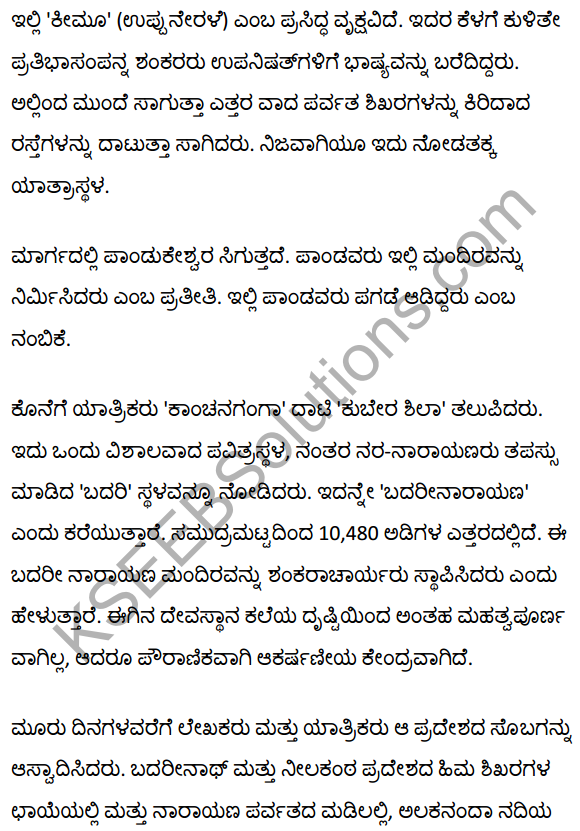

मेरी बद्रीनाथ यात्रा Summary in English
This lesson, written by Vishnu Prabhakar, is a travelogue. It describes the author’s trip to Badrinath.
The author begins by saying that the pristine beauty of the Himalayas can make a poet out of an illiterate, and can also make a blind man see. The beauty of the snow-clad peaks of the Himalayas deeply touches the human mind. After the many forms (tributaries) of Ganga like Garuda Ganga and Vishnu Ganga, and after crossing pristine locations like Pandukeshwar temple, the mulberry trees and Kuber Shila, one arrives at the Badrinarayan temple.
The ancient poet Kalidasa called the Himalayas as ‘Nagaadhiraj’. In the shadow of these great mountains, the unending flow of the tributaries of Ganga continues, as if chanting the name of God. In the jungles of Deodars and Bhojpatra, one can find carnivorous animals as well as herbivores like the musk deer. Since ancient times, man has undertaken expeditions across the inaccessible regions of the Himalayas. On one occasion, around September-October, the author undertook a trip to the Himalayas with his friends. This lesson is a description of this trip.
The travellers proceeded From Haridwar to Peepalkoti, past Usheemath, the winter capital of Kedarnath, and the Tunganath temple. Some travelled on foot, while others proceeded on stilts. Every day the travellers covered a distance of 12 to 18 kilometres. It was surprising that despite life-threatening and difficult ups and downs along the path, no one felt tired. The many vantage points, such as Gangotri, Yamunotri, Kedarnath, Badrinath and Chaukhamba were all glistening in the sunlight. By afternoon, all of it would get hidden by the shadows of the tall mountains.
The trek from Garuda Ganga to Pataal Ganga began. Instead of a road, there was a very narrow and zig-zag path that looked like a streak of lightning on a dark night. This is where Parvati did her penance in order to marry Lord Shiva. Badrinath is a further 19 kilometres away from Joshimath. One of the four ‘Mathas’ established by Adi Shankaracharya can be found here. Here, one can also find the ‘keemu’ or ‘shahatoot’ (mulberry) trees. Sitting under the tree, the great Adi Shankara wrote his commentaries on the Upanishads. Moving forward, one arrives at the Vishnuprayag, which is the point of confluence of the rivers Alaknanda and Vishnu Ganga. It is quite a scary spot, but when has mankind lost courage among high mountains” and deep valleys?
Pandukeshwar, which was established by King Pandu, and where the game of ‘Chausar’ (a game played with oblong dice) was first played, is in this region. There are also many deodar trees in this region. From here, one has to get across Kanchan Ganga in order to get to ‘Kuber Shila’. The mountains on either side of the Alaknanda river are called Nar-Narayan. There was once a date/plum forest in this area. The Indian date (Ber) is also called Badri (also referring to the source of the Ganga). The Badrinath temple is found at a height of 10,480 feet. This temple is not attractive from an artistic point of view, but it still attracts huge crowds of devotees and holds the charm of nature. This town is considered the last settlement at the border of India.
The water from the hot springs (Tapt Kund) here is so hot that one cannot put one’s hand in it. It is very pleasing to see that even the poor and people from the lowest rung of the society are allowed into the temple. In this way, the author enjoyed the bountiful beauty of nature on his trip, along with his fellow travellers.
कठिन शब्दार्थः
- अलख – अगोचर, जो देखा न जा सके;
- अछूता – जो छुआ न गया हो;
- कुहरे – ओस, ಮಂಜು mist;
- धर्मभीरू – धर्म से डरनेवाला;
- पगडंडी – पैदल जाने का रास्ता, ಕಾಲುದಾರಿ;
- कोलाहल – शोर, ಶಬ್ದ;
- डांडी – संकीर्ण रास्ता;
- कारवाँ – यात्रियों का समूह;
- घिधियाना – गिड़गिड़ाना;
- शहतूत – एक प्रकार का वृक्ष जिसका फल मीठा होता है;
- क्याँगचू – एक पंछी जिसका पैर लाल होता हैं;
- कंडी – लकड़ी का झूला.।
